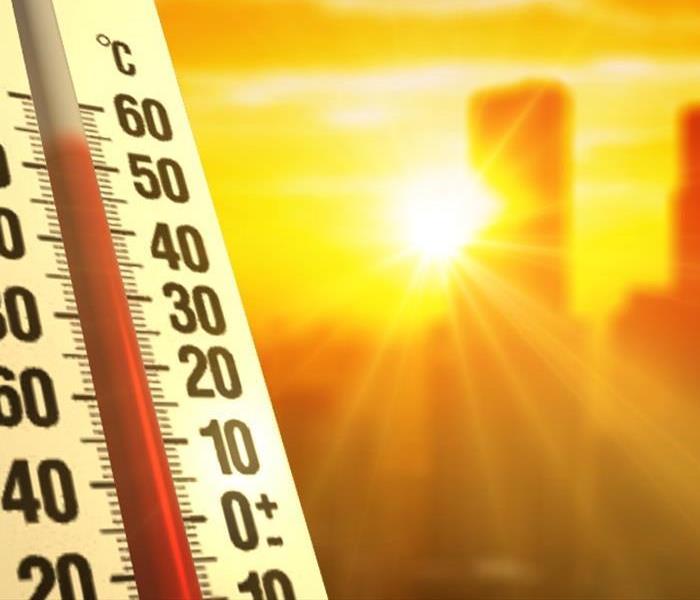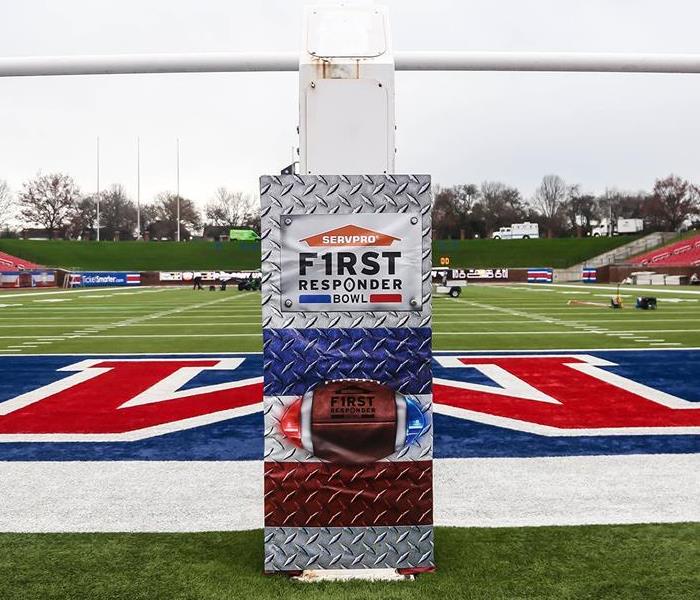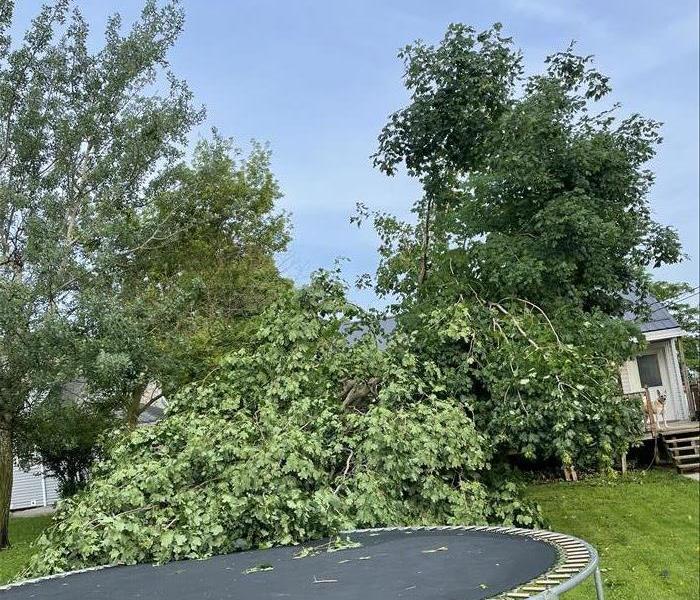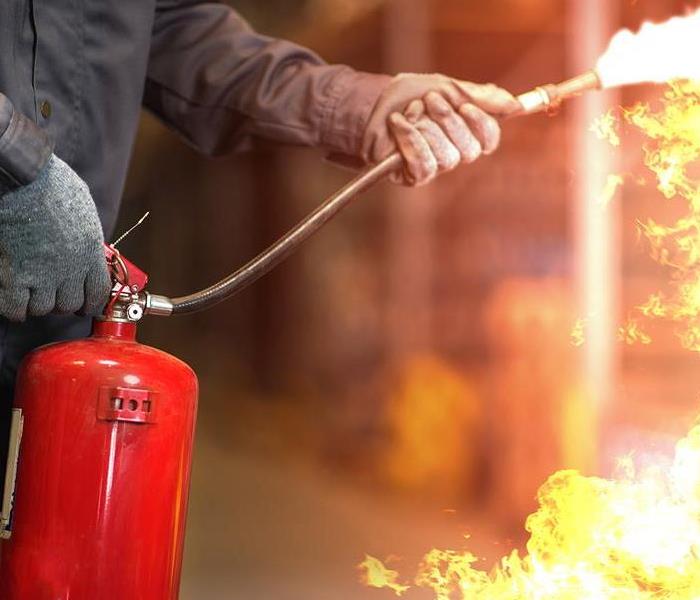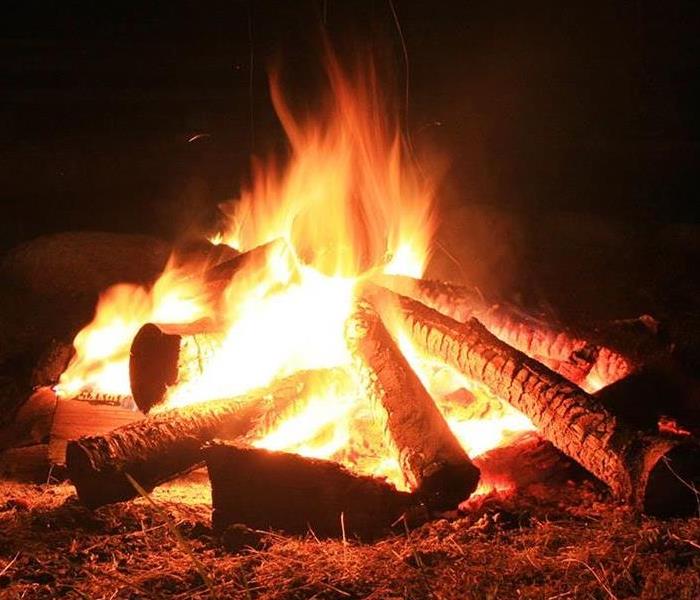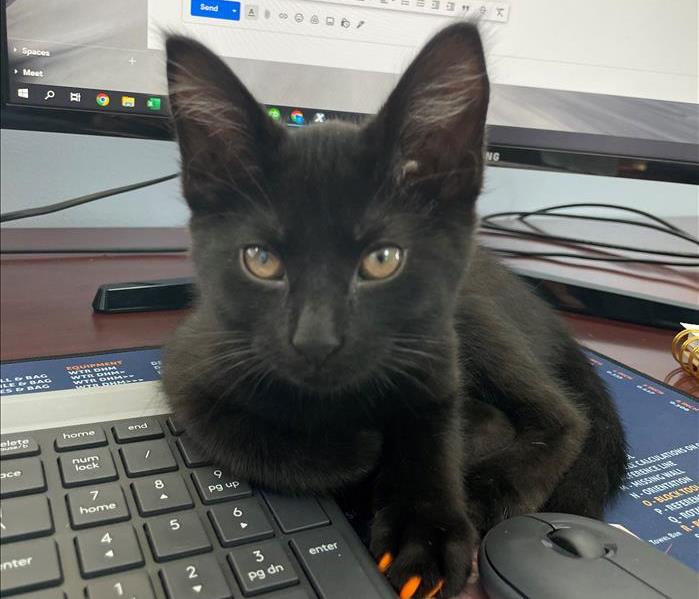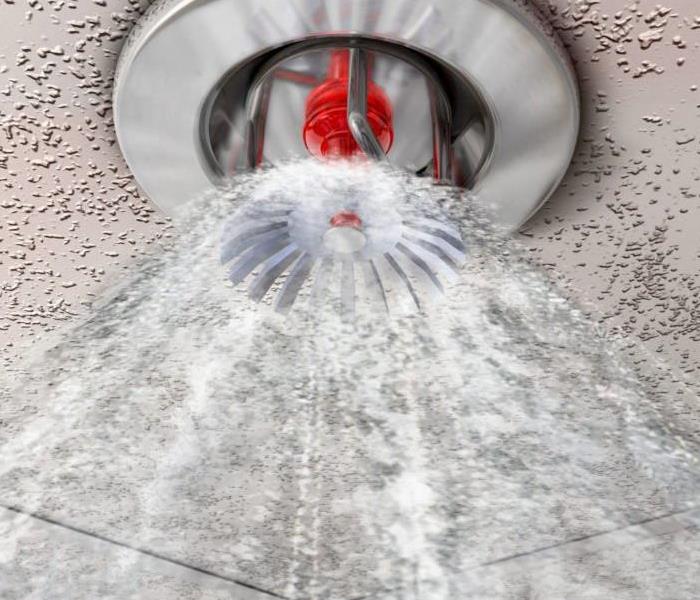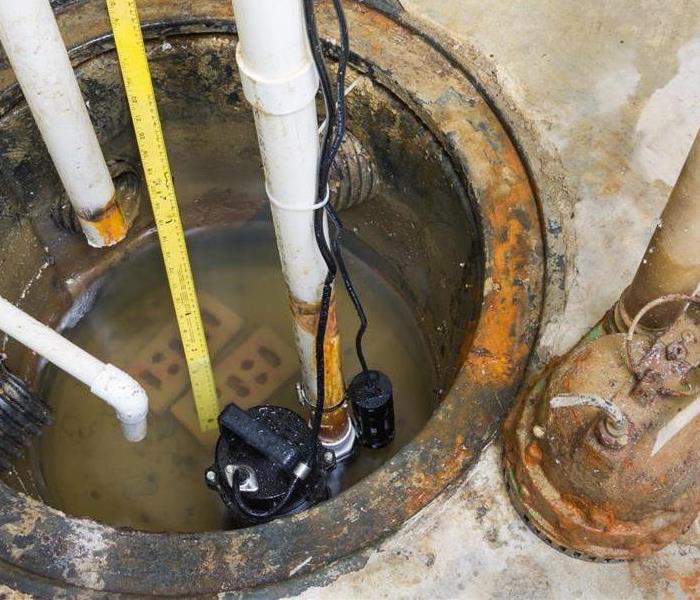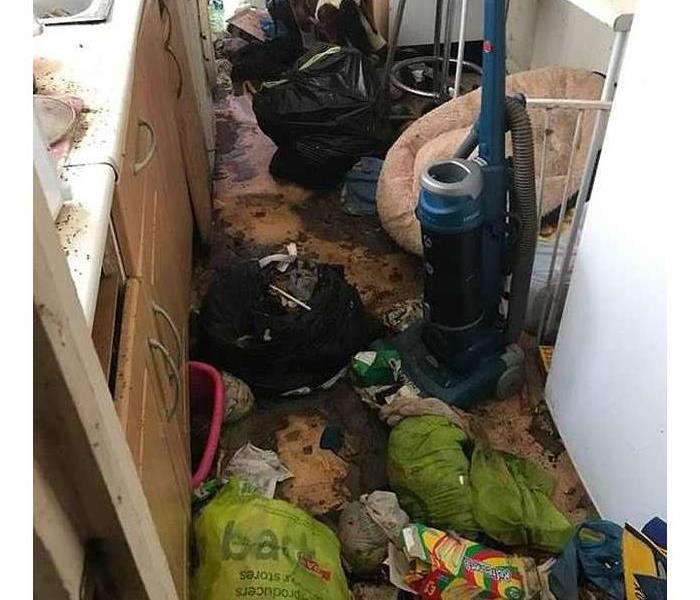Archived Blog Posts
Logan County Worker's Facing Extreme Heatwave
6/20/2022 (Permalink)
The Summer Solstice occurs tomorrow, marking the official start of summer. While summer is loved by many in Ohio, anyone out in the elements should take extra precautions during the long hot days. Most employees who work in construction, landscaping, farming, and many other industries do not have the option to work from home or from a comfy air-conditioned office so keeping them knowledgeable about heat related illness is the best way to keep them safe. Here are the most common illnesses caused by heat and what to do if an employee is showing symptoms:
Heat Rash
Red patches that are usually located on the neck, chest, groin and in elbow creases and contain small pimple like blisters. This is not life threatening but treatment should include staying in a cool, dry place, keeping the rash dry, and using a power (like baby powder) to soothe the rash.
Sunburn
While most sunburns can be treated at home a severe sunburn can result in hospitalization. Sunburns make the skin painful, red, and warm some even resulting in blisters. Treatment for sunburn include staying out of the sun until the burn heals, taking cool baths or placing cool cloths on skin, or using moisturizing lotions and aloe on affected areas. One should never pop a blister from a sunburn.
Heat Cramps
Heat cramps cause muscle pain or spasms, and heavy sweating during exercise or manual labor. They can usually be fixed by stopping physical activity and moving to a cool place, drinking water or a sports drink and simply waiting for the pain to stop. Seek medical help if the cramps last longer then 1 hour, or you have heart problems.
Heat Exhaustion
Signs of heat exhaustion include heavy sweating, fast but weak pulse, nausea, muscle cramps, dizziness, headache, cold, pale, clammy skin, and fainting. Heat exhaustion can usually be treated by moving to a cool place, sipping water, loosening clothing, and placing cool cloths on skin. Seek medical help if you experience vomiting, your symptoms get worse or last longer than an hour.
Heat Stroke
This is the most dangerous of the heat related illnesses and should be treated as such. People experiencing a heat stroke will have a high body temperature (103 degrees Fahrenheit or higher) fast and strong pulse, hot, red, dry, or damp skin, confusion, headache, dizziness, nausea, or lose consciousness. Call 9-1-1 right away, while waiting for emergency services you can move the person to a cooler place and place cool cloths on skin to bring temperature down. You should never give someone experiencing a heat stroke anything to drink.
When you or your employees are working outside in this extreme heat remember to always drink plenty of water, even when you’re not thirsty. Avoid alcohol and sugary drinks since these can dehydrate you more quickly. Try to schedule labor intensive jobs for the early morning or late evening to beat mid-day heat. Use a wide brimmed hat to keep rays off and loose, lightweight clothing to keep cool. Wear and reapply sunscreen as directed to protect from sunburns. Try to spend time indoors with A/C during breaks and after work if possible. Always encourage co-workers to rest and drink plenty of water throughout the day. Spending a few moments with your crews to go over some of these tips could be a potentially life saving conversation, so please don’t hesitate.
Wishing you all a safe and cool summer from your friends at SERVPRO of Central Auglaize/Hardin/Logan Counties.
Send your Favorite First Responder to the SERVPRO First Responder Bowl
6/16/2022 (Permalink)
Our team at SERVPRO is so grateful for all the first responders out there! We recognize and appreciate the brave work you do for our communities, always running towards the danger. We have witnessed the damage left behind when your heroic work is done and feel honored to be able to help with the clean up after a fire, storm, or other disasters. You give so much of yourself to others, so we think it’s time to give back.
Since 2018 SERVPRO has sponsored the SERVPRO First Responder Bowl in Dallas, Texas to honor the Everyday Heroes across the country. The game will be held December 27, 2022, and SERVPRO is giving away 1,000 complimentary first responder tickets on a first-come-first-serve basis starting at the end of the summer.
If you or a loved one is an Everyday Hero, please go to firstresponderbowl.com , and click on the TICKET tab to claim your free ticket. Also be sure to check out our Everyday Heroes Wall presented by LiquidAgents and StaffDNA where you or a loved one can be featured with other brave first responders across the country.
THANK YOU to all the first responders from your friends at SERVPRO of Central Auglaize/Hardin/Logan Counties. If you have any questions or need assistance registering, please call us at 937-354-3540.
Summer Power Outage in Logan County
6/16/2022 (Permalink)
Strong thunderstorms with damaging winds ripped through Logan County earlier this week taking with it trees and power lines leaving thousands of residents without power, some for days now. This week has also brought with it a heatwave making a bad situation worse. While power companies are working around the clock to restore power to all customers it’s always good to be prepared when something like this happens. Here are a few tips to help you deal with prolonged summer power outages.
- Keep Emergency Supplies on Hand
Having an emergency supply kit on hand is the first step in being prepared for a power outage. Kits should include water and non-perishable food, enough for 3 days for every person living in the home, cell phone or land line, emergency contact list, flashlight, and battery-operated radio.
- Keep Refrigerator and Freezer Doors Closed
Keeping the doors closed will greatly aid the unit in holding its temperature. The CDC states that food will hold in a refrigerator for 4 hours, while a full freezer can hold food for 48 hours, and a half full freezer will hold for 24 hours.
- Keep Outside Doors and Windows Closed
Shading the house with curtains and blinds and keeping doors and windows closed will keep as much of the cool air from going out and the warm air from coming in as possible.
- Check for Cooling Stations in your Community
When residents are without power for prolonged periods most communities will have cooling stations set up around the city providing them somewhere to go to cool off when temperatures are dangerously high.
- Check on Friends and Neighbors
Infants and children up to the age of four, people over 65, people who are overweight, and people who are ill or take certain medications are at a higher risk for heat related illnesses, check on neighbors and friends to make sure they are staying safe.
- Keep Pets Hydrated
Heat affects our pets the same way it affects us. Always make sure they have access to clean, cool water.
- DIY a Battery Powered A/C Unit
There are lots of tutorials available online for homemade A/C units, most use a sealed container, a pipe, fan, and ice to provide cooling relief. Make sure your fan is battery operated so it can be used during a power outage.
- Keep Activities for Kids on Hand
Kids can get impatient during a power outage, and when power is limited screen time may not be an option so keeping things like coloring books, crayons, boardgames, and other activities on hand is always a good idea.
Even with the best preparations disaster can still strike. If you experience a storm loss in your home or business call the restoration professions, SERVPRO of Central Auglaize/Hardin/Logan Counties at 937-354-3540.
Choosing the Right Fire Extinguisher for your Business
6/15/2022 (Permalink)
As a business owner, fire safety should be a top priority when thinking about your employees and facility. While there’s no sure-fire way to prevent a fire from occurring, extinguishing the flames quickly will greatly reduce the damage that is left behind. Having a fire extinguisher on hand is a great way to combat the flames. Did you know there are different classes of fire extinguishers that extinguish different kinds of fires? Here is a brief description of each of the classes to help you choose which extinguisher is right for your facility.
Class A
-Safe for use on ordinary combustible fire, use on materials such as cloth, wood, rubber, paper, and plastics.
Class B
-Rated for use on flammable liquids, use on materials such as gasoline, grease, and oil.
Class C
-Safe for fires that are electrically energized.
Class D
-Safe to use on combustible metals like titanium and magnesium.
Class K
-Rated for kitchen fires safe to use on grease, cooking fat, and oil fires.
In the event that a fire can’t be extinguished or damage is left behind, SERVPRO of Central Auglaize/Hardin/Logan Counties is always Here to Help. Call us today at 937-354-3540.
Content Restoration after a Fire
6/14/2022 (Permalink)
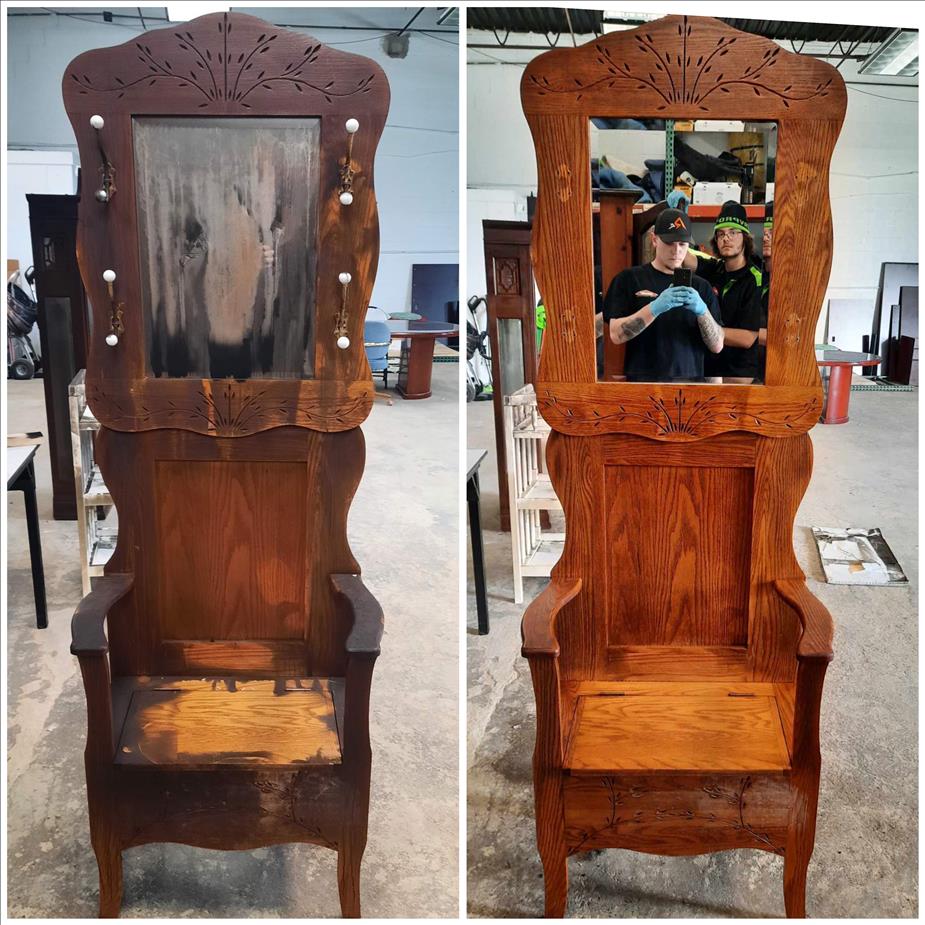 Before and After of a restored piece of furniture.
Before and After of a restored piece of furniture.
Experiencing a fire in your home or business can be one of the most devastating and stressful disasters you ever encounter. Even when the structure of a home or business is considered a total loss there’s still potential for saving some contents. In most cases items that have not been damaged directly by the fire or from excessive heat can be salvaged. However, cleaning of these items should be done by professional restoration company like SERVPRO of Central Auglaize/Hardin/Logan Counties.
Safety is our first priority when handling a fire loss for all occupants, our workers, and anyone else who enters the facility. After a fire the indoor air contains floating smoke and soot particles, these are carcinogens and can be toxic and dangerous, always wear a mask. Never handle items from a fire with your bare hands, gloves should be worn, preferably rubber or latex to protect yourself, and the contents from the oils on your skin that can set the soot. Assessing the items quickly helps to minimize soot damage that can be incurred in just a few hours or days after a fire.
SERVPRO of Central Auglaize/Hardin/Logan Counties has the knowledge and expertise to bring your smoke damaged contents back to pristine shape. Fire restoration service available for the following items:
- Furniture, shelving, and light fixtures
- Drying and document restoration
- Soft goods including garments, upholstery, bedding, and carpet
- Electronics and appliances
- Art restoration
- Children’s Toy
- Antiques
If you experience a fire in your home or business, don’t hesitate to call us at 937-354-3540.
Safety Tips for you Fire Pit
6/14/2022 (Permalink)
Nothing screams summer more then gathering with friends and family around a campfire. While this is a pastime enjoyed by many, safety precautions must be taken anytime you’re dealing with an open flame. Here are 10 tips to help keep you and your loved ones safe.
- Check the Wind Conditions
Never attempt to start a fire with unusually strong winds, kindling can blow to surrounding brush and structures creating the threat for a fire.
- Burn in an Open Area
Never start a fire under over hangings or near trees, always keep lawn furniture and flammable materials away from the fire.
- Don’t Burn Treated Lumber
While it may be tempting to burn any extra lumber you have from a project around the house, construction materials like MDF, pressure-treated boards, and plywood are treated with chemicals that admit toxic fumes.
- Be Prepared to Extinguish the Flames
Best practices include keep a fire extinguisher or fire blanket on hand. Other safety measures can be having a hose near by to quench the flames and a shovel to smother the flames with dirt.
- Keep Chairs Back
While it may be tempting, especially when roasting marshmallows, never put your chairs too close to the fire. It’s also best to keep sleeves rolled up and hair pulled back when cooking over an open flame.
- Keep Small Children and Pets at least 3ft back
Setting a boundary for how close kids and pets can come to an open flame greatly reduces the potential for them to accidentally injure themselves. Draw the line and stick to it.
- Never Leave a Fire Unattended
Even if it seems like the flames have died down never leave a fire unattended until it is completely extinguished. Pour water on live embers and turn logs to make sure all sides of wood have stopped burning.
- Please Drink Responsibly
Not only is alcohol flammable it can greatly impairs coordination, reflexes, and judgment which could be potentially dangerous to everyone around the fire.
- Check for No-Burn Alerts
When weather conditions and high emissions combine to increase pollution, some municipalities will issue no-burn alerts. These should be followed to keep yourself and your community safe. Failure to comply may result in fine.
- Store Firewood Safely
Keep firewood a safe distance from the fire pit. While it may be tempting to stack next to the pit when you’re feeding the fire, distance helps prevent the fire from jumping and feeding itself.
Wishing you all a fun and safe summer from your friends at SERVPRO of Central Auglaize/Hardin/Logan Counties!
Water CATs..?
6/10/2022 (Permalink)
When you think of water, cats probably aren't the first thing that come to mind, but when you have a water loss in your home or business it is best to act fast. Not only does this assure that you will get back normal as soon as possible but delaying the mitigation process can affect the category of water in your facility. The category of water is a major factor in mitigation. Here is a brief description of each category of water and how it effects the mitigation process.
Category 1
- This category of water has come from a clean source with little threat of causing sickness or discomfort.
- The water can remain a CAT 1 if it has not been present for an excessive amount of time and the affected materials are clean and well maintained.
- Some examples of CAT 1 water sources could be water supply line, sink overflows with no contaminants or an appliance water supply line malfunction.
- CAT 1 water loss usually need minimal demolition and can be dried.
Category 2
- This category of water has potential to cause sickness or discomfort and should not stay in a structure for an extended period.
- Potential sources of CAT 2 water loss include waterbed leaks, aquariums, washing machine and dishwasher discharge, and toilet bowl overflows (urine only)
- At a minimum affected carpet pad must be removed and carpet must be cleaned with hot water extraction before it can be reinstalled.
- Another good practice with a CAT 2 water loss is to spray an anti-microbial to all affected areas to prevent any further damage.
Category 3
- This category of water come from a grossly unsanitary source and contains pathogenic agents.
- Some sources of CAT 3 water include groundwater (flood water) and discharge from toilet that came from beyond the toilet trap (sewer or septic system).
- Many procedures are necessary when dealing with CAT 3 water including several forms of PPE (personal protective equipment) such as rubber boots, respiratory protection, body coverings, rubber gloves and eye protections. Anyone with a compromised immune system must leave the facility. Occupant and worker safety top priority when working with hazardous materials.
- Demolition must be performed on highly porous materials including but not limited to carpet, carpet pad, drywall, and insulation.
- Restorers should apply biocide during and after demolition to help control microorganisms and increase cleaning effectiveness.
The category of water is deteriorating the longer the water sits, so If you experience a water loss in your home or business please don’t hesitate to call SERVPRO of Central Auglaize/Hardin/Logan Counties at 937-354-3540.
Sprinkler System in your Commercial Building
6/10/2022 (Permalink)
Fire sprinklers are a common safety feature in most commercial buildings. They don’t normally malfunction, but when they do, they bring with them the potential for flooding, and thousands of dollars in water damage. Maintenance is a must for these systems, and we recommend having them inspected by a professional at least once a year to keep your employees and facility safe. Even with the best maintenance there is still a chance of a system failure, so here are the first few steps to take should you encounter a loss due to your sprinkler system.
- Shut the Water Off
Seems like common sense but having a good understanding of where the shut-off valves are located and getting to them quickly is going to be the best way to minimize the amount of water entering the facility.
- Call your Agent
Reach out to your insurance company so they can get the claim process started. They will likely send out an agent to assess the damage.
- Take Photos
Documentation is key during a loss. Do not remove any of the damaged materials, but instead take phots and videos so you have proof of everything that was damaged in case there are any disputes once work is completed.
- Call SERVPRO of Central Auglaize/Hardin/Logan Counties
Calling a commercial restoration company after a large loss is always recommended. Fire sprinkler systems can disperse a substantial amount of water and should not be looked at as something that you can clean up yourself.
No matter the size of the loss, SERVPRO of Central Auglaize/Hardin/Logan Counties has the knowledge and expertise to make your facility “Like it never even happened.” Call us at 937-354-3540 today!
Tornado in West Liberty, OH
6/9/2022 (Permalink)
With a tornado touching down in West Liberty, OH last night we just wanted to send out a reminder about tornado safety. We at SERVPRO of Central Auglaize/Hardin/Logan Counties are “Ready for whatever happens” and we want our community to be as well.
Tornado season in Ohio peaks in May June and July but they can strike any time day or night and at any time during the year. Tornadoes are most common in the Central Plains and Southeast United States, but they have been reported in all 50 states. A tornado is a rotating column of air coming from the bottom of a thunderstorm towards the ground. They are extremely powerful and can uproot trees, destroying well-made structures, and hurling object through the air like missiles.
The best way to protect yourself and your family is to have a plan in place if you ever encounter one of these powerful storms. Here are some tips to help keep you safe.
Before the Storm
- Know the signs of a tornado. Watch for rotation, funnel shaped clouds, and flying debris. Listen for load roaring, some compare it to the sound of a freight train.
- Be sure to keep an eye on weather conditions and sign up for your community’s warning system. NOAA weather radio and The Emergency Alert System (EAS) also provide this information.
- Find a safe place in your home to go during a storm and practice going there with your family. Best place to go is a basement or a small, interior, windowless room on the lowest floor of a sturdy building.
- Have emergency supplies available in that room in case you are sheltering in place for extended periods. Emergency supplies should include water, non-perishable foods, medical supplies, and medications.
- Keep photos of the interior and exterior of your home in case your property experiences damage you will have photos to bring your home back to preloss conditions.
During the Storm
- Immediately gather your family and head to safe location you have identified.
- Pay attention to local alerting systems, NOAA Weather Radio, or EAS.
- Keep yourself protected by covering your head and neck with your arms or using materials such as blankets and furniture.
- If outdoors with no access to a building or in vehicle try to keep head and neck protected with arms and blankets/coats if possible. If you are in a vehicle, never try to outrun a tornado.
After the Storm
- Check local authorities, EAS, or NOAA weather radio to make sure coast is clear before leaving your safe location.
- Always stay clear of broken utility lines or fallen power lines.
- Contact your health care provider or emergency services if you are injured.
- Wear protective gear when cleaning up any debris. This should include work gloves, long pants, thick-sole shoes, and masks if necessary.
If you do experience a loss caused by a tornado contact SERVPRO of Central Auglaize/Hardin/Logan Counties 24/7 at 937-354-3540 so we can make it “Like it never even happened.”
Summer Barbeque Safety Tips
6/9/2022 (Permalink)
If you’re anything like us at SERVPRO of Central Auglaize/Hardin/Logan Counties summertime means grilling time. There’s nothing quite like the smell and taste of food fresh from the grill. While this is a great summer pastime it can also be very dangerous. There’s an average of 8,700 fires in the US every year caused by outdoor grills and barbeques. Here are some tips and tricks to keep you and your family safe this summer.
- Keep your grill at least 10 feet away from side of house and deck railings. Never place it under an overhanging, near trees, or any other lawn furniture that could potentially catch fire.
- Never grill indoors. While it may be tempting, especially in the cooler months of the year, this poses risk for a fire and carbon dioxide in the home.
- Keep grill clean of grease and build up, they can cause flare-ups and add fuel to fires.
- Check for gas leaks using soapy water and if it is leaking it is time to replace.
- Be ready to put fire out. Having a fire extinguisher on hand is best practice. Baking soda is also a good option for a grease fire. Never put water on grease fire. If you are unable to extinguish the fire do not hesitate to call 911.
- When cooking with charcoal keep lighter fluid use to a minimum and never apply it to an open flame.
- Never turn the gas on your grill with the lid closed. This can cause the gas to build up and when lit create a fireball.
- Never leave the grill unattended.
- Always remember to turn the grill off when complete.
- Let coals cool completely before you dispose of them.
If you do experience a fire don’t hesitate to call SERVPRO of Central Auglaize/Hardin/Logan Counties for emergency services 24/7 at 937-354-3540.
Maintaining your Sump Pump
6/9/2022 (Permalink)
Summertime in Ohio is beautiful, but also brings with it the potential for severe thunderstorms. These can be damaging to your home due to high winds, down branches and of course flooding. Sump Pumps are your first line of defense against rainwater entering your home and causing damage, so making sure they are functioning properly is something homeowners should check regularly. The average cost to repair a unit is around $450 while replacing is closer to $1000, making both options more frugal decisions then the potential for thousands of dollars in water damage to your home due to sump pump failure. SERVPRO of Central Auglaize/Hardin/Logan Counties suggest having your sump pump looked at by a professional if you’re experiencing any of the following
- Making strange noises such as rattling or grinding.
- If the unit is vibrating excessively when running.
- Infrequent pump use will shorten shelf life.
- Constantly running
- If the unit is cycling irregularly
- Notice any visible rust
- If the unit is 7 years or older, shelf life for a sump pump is usually around 10 years.
- Motor gets stuck or motor has stopped working.
If you do experience a water loss in your home due to sump pump failure or any other cause we are available 24/7 for Emergency Services at SERVPRO of Central Auglaize/Hardin/Logan Counties, contact us at 937-354-3540.
Free Service for your Logan County Business
6/9/2022 (Permalink)
Murphy’s law simply states, “Anything that can go wrong will go wrong”. While some may see that as a pessimistic point of view, we at SERVPRO of Central Auglaize/Hardin/ Logan Counties see that as a challenge we’re ready to help your business combat.
SERVPRO Emergency READY Plan Profile is an easy way to have critical information about your facility at your fingertips should, and if Murphy’s law is correct, WHEN disaster occurs. According to industry research 50% of businesses may never recover following a disaster. That’s why taking the time to have a plan in action before disaster occurs allows mitigation to happen quickly, reducing business interruption.
If you were sitting at your desk and a pipe broke overhead, would you know where the main shut off valve is? Perhaps you do know, but if you were out of the office would all other members of staff have the same knowledge? A great advantage of the SERVPRO Emergency READY Plan Profile is having shut-off valve location details that can easily be distributed to staff. They would also know who to contact should a disaster occur and what they can expect from us.
These are just a few benefits of this completely free service we offer here at SERVPRO of Central Auglaize/Hardin/Logan Counties to all businesses who want to be “Ready for whatever happens.” Contact our office at 937-354-3540 for more information or go to https://ready.SERVPRO.com to get started today!
Who you gonna call?... SERVPRO
6/9/2022 (Permalink)
As a commercial or residential property manager you know that you must be “Ready for whatever happens”. This is a motto SERVPRO of Central Auglaize/Hardin/Logan Counties knows a thing or two about as well. Whether it’s a tenant who vandalized a property or natural disaster like a flood we have the tools and knowledge to get your property back to preloss conditions. Our highly trained technicians offer services for:
- Commercial water damage restoration
- Commercial fire damage restoration
- Commercial mold damage restoration
- Commercial storm damage restoration
With over 50 years of experience in commercial and residential restoration services, you will have peace of mind that we can handle your job no matter the size. We’re always here to help! Emergency Services available 24/7 Call SERVPRO of Central Auglaize/Hardin/Logan counties today at 937-354-3540.
Stay Safe During Tornado Season in Logan County
5/9/2022 (Permalink)
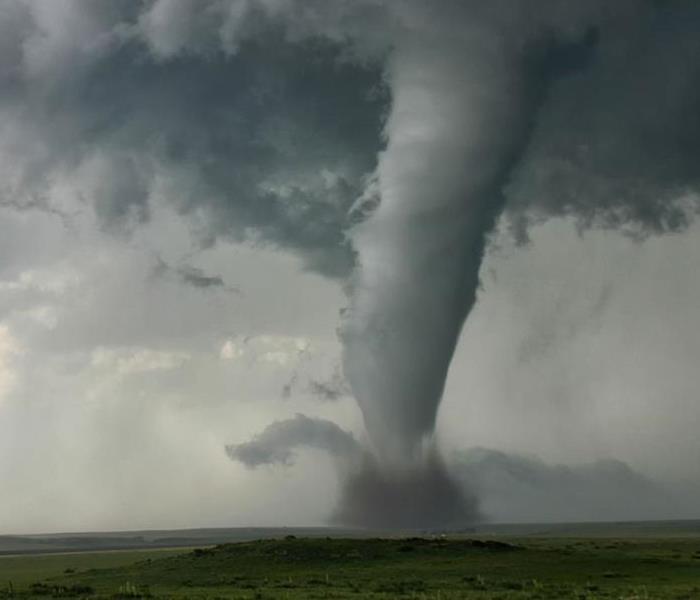 With changing weather, mixes of cold and warm fronts can produce disastrous storms including tornadoes.
With changing weather, mixes of cold and warm fronts can produce disastrous storms including tornadoes.
Tornado season is here and pop-up storms and weather patterns during the shift of the seasons bring the ingredients to produce tornadoes in the Logan County area. SERVPRO of Central Auglaize/Hardin/Logan Counties is prepared and always here to help! Here are 5 tips to prepare your home or business in the event a tornado event was to happen.
- Create a Disaster Kit.
- Flashlights; Batteries; Extra shoes for entire family; Bottled water; First aid kit. Photograph/video home and contents with time stamps.
- Create a Family Communications Guide.
- Have a plan to reach other family members. A meeting place if communication systems are down.
- Follow Evacuation Plans.
- In the event evacuation plans are put into place, act on them immediately.
- Know What to do During a Tornado.
- Lowest level of the home (basement); inner most portion of the home; away from windows.
- Know What to do After a Tornado.
- Shelter locations; food and water distribution; photographs of damage.
If a tornado does bring damage to your home or business SERVPRO of Central Auglaize/Hardin/Logan Counties is available 24/7 and ready to respond call us at 937-354-3540
Storms in Logan County Can Produce Hail
5/9/2022 (Permalink)
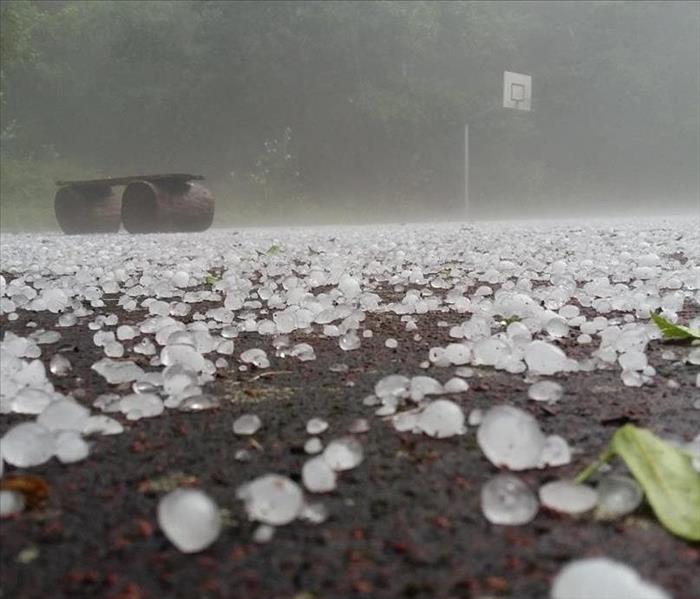 Hail that has fallen during a storm with sizes capable of producing heavy damage.
Hail that has fallen during a storm with sizes capable of producing heavy damage.
Why is Hail so Dangerous?
Hailstones generally fall at higher speeds as they grow in size, though complicating factors such as melting, friction with air, wind, and interaction with rain and other hailstones can slow their descent through Earths Atmosphere. Severe weather warnings are issued for hail when the stones reach a damaging size, as it can cause serious damage to human-made structures, and, most commonly, farmers' crops.
What should you do if your property is damaged by hail?
- Photos of all damaged property.
- Photos/Videos of the hail before it melts
- Board up any broken windows.
- Tarp holes in roof.
SERVPRO of Central Auglaize/Hardin/Logan Counties is ready for whatever happens.
We have the ability to secure a damaged home or business in order to minimize and prevent secondary damages.
We are available 24/7 at 937-354-3540.
HVAC Tune-ups a Must for Hardin County
5/9/2022 (Permalink)
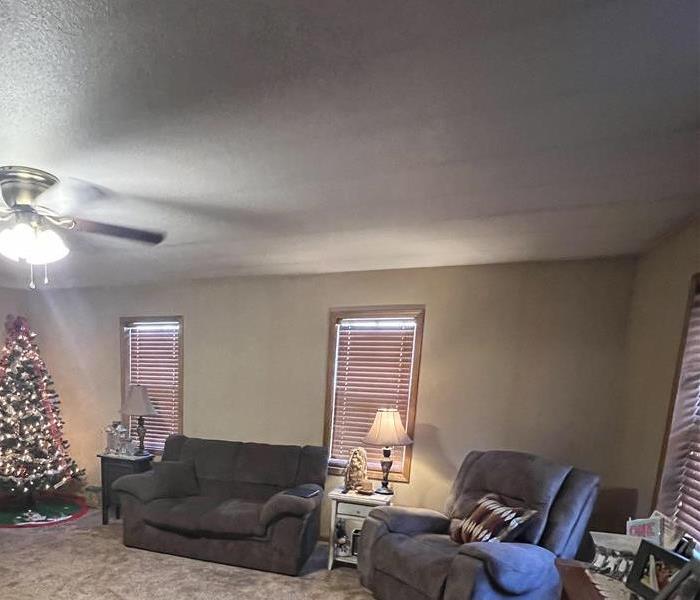 This family room was affected by a blocked orifice tube in a propane fire place.
This family room was affected by a blocked orifice tube in a propane fire place.
How often should you tune up your HVAC system?
You should schedule HVAC tune-ups one to two times per year depending on the age of your system. If your system is five years old or older, schedule two tune-ups per year. If you have a newer system, an annual tune-up should be sufficient.
Why regular HVAC maintenance is important?
You depend on your HVAC system to keep you comfortable year-round. Regular maintenance helps your system produce and distribute the warm or cool air more evenly and steadily. It also reduces the odds that you'll come home from work one winter's day to find frigid air blasting through your vents.
Affects of an un-serviced HVAC system.
If orifice tubes are clogged or blocked it could produce an oil discharge into your home. This discharge is like smoke produced by an oil fire. It could be so faint that you won’t notice it until you start to see the outlines of wood framing. If you find yourself in this situation using correct cleaning methods is extremely important and if done improperly could make cleaning much more difficult.
SERVPRO of Central Auglaize/Hardin/Logan Counties is a Certified Firm with a Master Fire and Smoke Restorer designation. You have questions, we have answers! Call us today at 937-354-3540.
Faster to your Logan County Water Damage
5/4/2022 (Permalink)
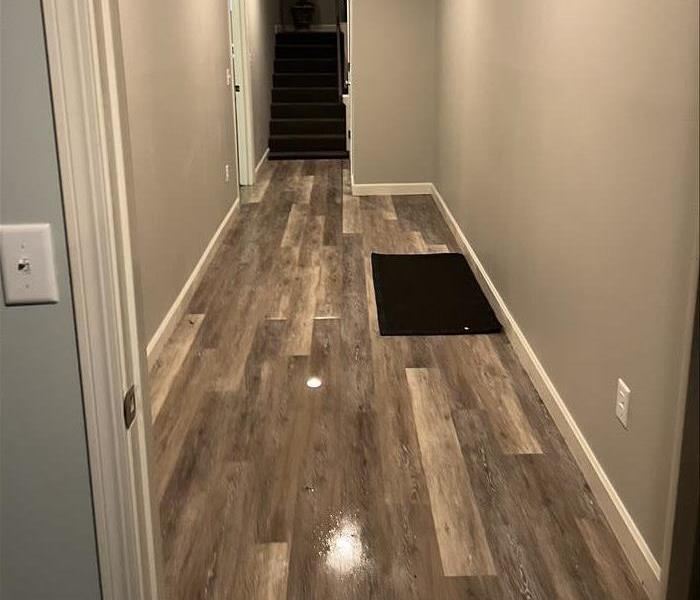 When standing water is found, the clock is already ticking.
When standing water is found, the clock is already ticking.
Water damage from broken pipes, sump-pump failures, and even toilet backups are very invasive. Water quickly spreads throughout your residence affecting building materials and contents. The faster the water is removed the less likely permanent damage sets in.
Hours 1 - 24:
- Drywall begins to swell and break down.
- Metal surfaces begin to tarnish.
- Furniture begins to swell and crack.
- Dyes and inks from cloth and paper goods spread and stain.
- A musty odor appears.
48 Hours to 1 Week:
- Mold and mildew may grow and spread.
- Doors, windows, and studs swell and warp.
- Metal begins to rust and corrode.
- Furniture warps and shows signs of mold.
- Paint begins to blister.
- Wood flooring swells and warps.
- Serious biohazard contamination is possible.
SERVPRO of Central Auglaize/Hardin/Logan Counties arrives quickly and starts the water extraction process as quickly as possible so we can get you back to your daily routine as fast as possible.
Need Emergency Water Services?
SERVPRO of Central Auglaize/Hardin/Logan Counties is available 24/7 at 937.354.3540
24hr Emergency Storm Damage service for Logan County
5/4/2022 (Permalink)
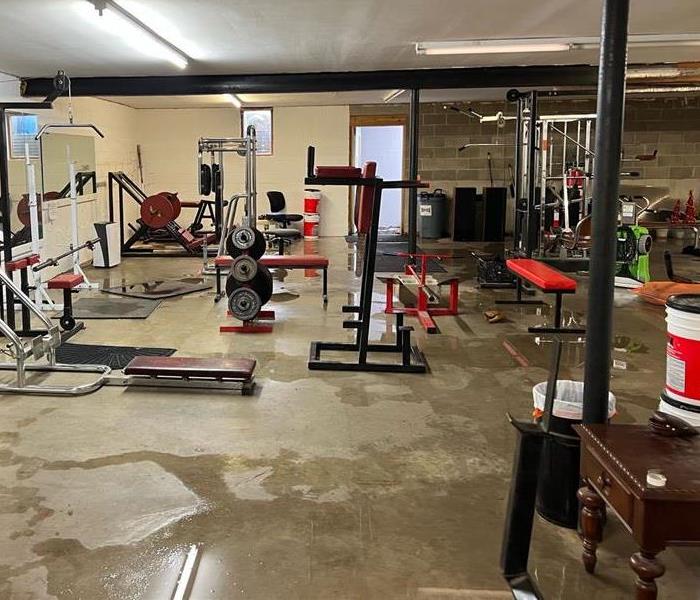 Standing water still in a basement after the sump pump was replaced.
Standing water still in a basement after the sump pump was replaced.
Storm Season and Being prepared in Logan County.
As the winter ends the spring rains are soon to follow. Ensuring your basement is protected should be the one thing done during that transition of seasons. here are a few tips to make sure you’re ready for the spring rains.
- Contact your insurance company to be more familiar with your policy. Ensure you have sufficient coverage for backups/Sump pumps/septic/sewage. Ensure you can replace loss personal property and building materials.
- Keep all expensive and favored possessions off the floor and away from low ground in case of flooding.
- Run a check on your sump pump by pouring water into the pit and ensuring the float engages and turn the pump on.
- Sump pump's older than 7 years should be changed.
- Install a battery backup system onto your sump pump in the event you lose power.
Call SERVPRO of Central Auglaize/Hardin/Logan Counties at 937.354.3540
Logan County Homes are in Good Hands with SERVPRO of Central Auglaize/Hardin/Logan Counties being a certified firm.
12/28/2021 (Permalink)
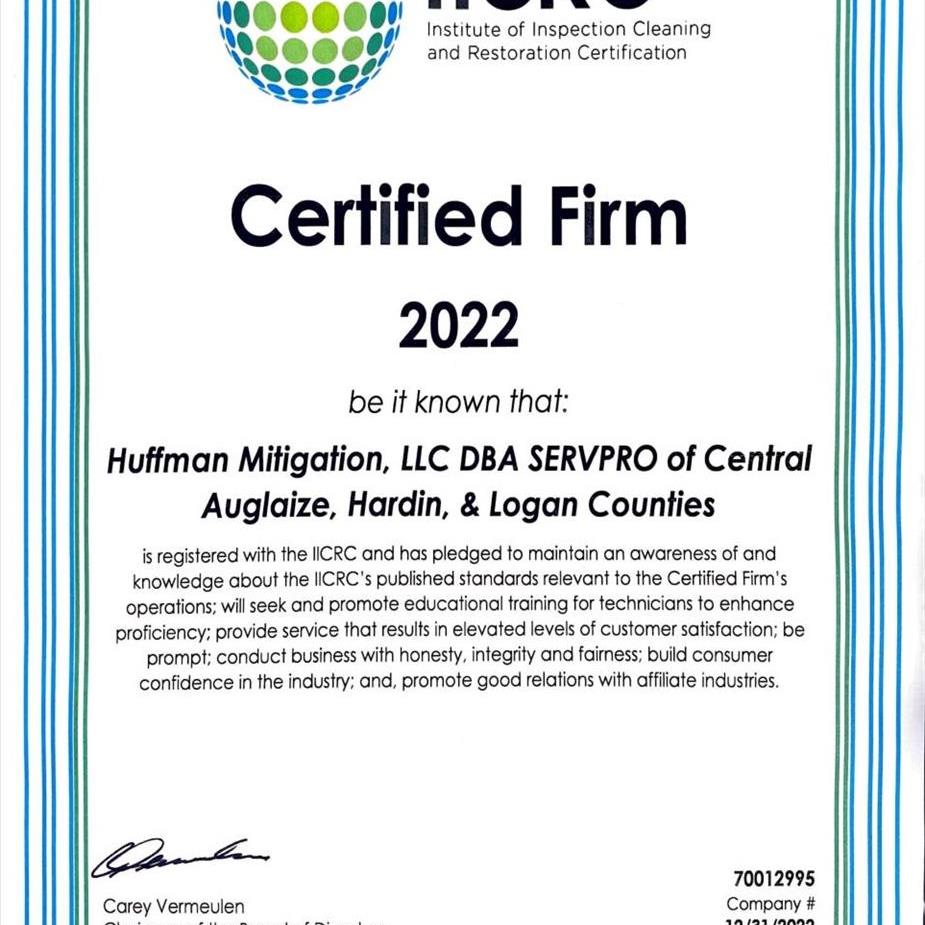 2022 Certified Firm Certificate for SERVPRO of Central Auglaize/Hardin/Logan Counties
2022 Certified Firm Certificate for SERVPRO of Central Auglaize/Hardin/Logan Counties
SERVPRO of Central Auglaize/Hardin/Logan Counties is an IICRC certified firm. The Institute of Inspection, Cleaning and Restoration Certification (IICRC) creates the standards for the restoration industry and provides training and certification to restoration companies. IICRC Certified Firms have the right to display the IICRC Certified Logo.
IICRC Certified Firms must
- Present accurate information to consumers and conduct business with honesty and integrity.
- Require a technician on all jobs who has been formally trained and passed all required tests.
- Require a continuing education program to keep technicians up to date on the latest changes in the industry.
- Maintain liability insurance to protect all parties in the event of an accident.
- Maintain a written complaint policy and agree to Better Business Bureau or similar arbitration to resolve disputes and accept the conclusions and recommendations of arbitration.
The IICRC Develops the Standards for The Restoration Industry
The IICRC has been the driving force in establishing the main industry standards and reference guides for professional carpet cleaning, water damage restoration and mold remediation. These IICRC standards take years to develop and require the coordination of experts in the field: manufacturers, industry organizations, insurance professionals, training schools, contractors, and public health professionals.
Every five years, the standards are reviewed and updated. The water damage restoration field changes rapidly with advancements in technology and science, and therefore the standards must evolve to keep pace.
Don't Have A Christmas Fire!
12/10/2021 (Permalink)
Every year we see an increase in fires around Christmas time. This is because many people don't realize the fire safety hazards that come along with certain Christmas traditions such as cooking a turkey or putting up a Christmas tree. Here are some things to keep in mind about fire safety during this holiday season:
- Make sure to replace old lights and use lights correctly, don't overuse your extension cords
- Don't make your tree a fire hazard, water your live tree daily and don't let it dry out or it could start a fire
- Be mindful of how close your tree and other items are to the fireplace
- Don't burn wrapping paper in the fireplace
- Use candles with care and caution, don't leave them burn at night or when you're away
- Use space heaters with care, these often cause fires
- Keep an eye on your delicious Christmas foods, stove fires are a huge hazard this time of year
Hope you have a Merry Christmas and Stay Safe. Remember, if you ever need any help with a fire clean up give SERVPRO of Central Auglaize, Hardin, Logan County a call!
Fire Clean Up In Your Bellefontaine Home
12/2/2021 (Permalink)
Smoke and soot is very invasive and can penetrate various cavities within your home, causing hidden damage and odor. Our smoke damage expertise and experience allows us to inspect and accurately assess the extent of the damage to develop a comprehensive plan of action.
Smoke and soot facts:
- Hot smoke migrates to cooler areas and upper levels of a structure.
- Smoke flows around plumbing systems, seeping through the holes used by pipes to go from floor to floor.
- The type of smoke may greatly affect the restoration process.
Different Types of Smoke
There are two different types of smoke–wet and dry. As a result, there are different types of soot residue after a fire. Before restoration begins, SERVPRO of Central Auglaize, Hardin & Logan counties will test the soot to determine which type of smoke damage occurred. The cleaning procedures will then be based on the information identified during pretesting. Here is some additional information:
Wet Smoke – Plastic and Rubber
- Low heat, smoldering, pungent odor, sticky, smeary. Smoke webs are more difficult to clean.
Dry Smoke – Paper and Wood
- Fast burning, high temperatures, heat rises therefore smoke rises.
Protein Fire Residue – Produced by evaporation of material rather than from a fire
- Virtually invisible, discolors paints and varnishes, extreme pungent odor.
Our Fire Damage Restoration Services
Since each smoke and fire damage situation is a little different, each one requires a unique solution tailored for the specific conditions. We have the equipment, expertise, and experience to restore your fire and smoke damage. We will also treat your family with empathy and respect and your property with care.
Have Questions about Fire, Smoke, or Soot Damage?
Call Us Today – (937)354-3540
Mold Basics In Logan County, Ohio
12/2/2021 (Permalink)
Mold Basics
- The key to mold control is moisture control.
- It is important to dry water-damaged areas and items within 24-48 hours to prevent mold growth.
Why is mold growing in my home?
Molds are part of the natural environment. Outdoors, molds play a part in nature by breaking down dead organic matter such as fallen leaves and dead trees, but indoors, mold growth should be avoided. Molds reproduce by means of tiny spores; the spores are invisible to the naked eye and float through outdoor and indoor air. Mold may begin growing indoors when mold spores land on surfaces that are wet. There are many types of mold, and none of them will grow without water or moisture.
How do I get rid of mold?
It is impossible to get rid of all mold and mold spores indoors; some mold spores will be found floating through the air and in house dust. The mold spores will not grow if moisture is not present. Indoor mold growth can and should be prevented or controlled by controlling moisture indoors. If there is mold growth in your home, you should have the mold professionally remediated and fix the water problem. If you clean up the mold, but don't fix the water problem, then, most likely, the mold problem will come back.
Helpful Questions to Ask When Your Kenton, OH Home Floods
9/13/2021 (Permalink)
Talk to your insurance agent about flood insurance. Here are helpful questions to ask your agent:
- Does my community participate in the National Flood Insurance Program? Flood insurance from the NFIP is only available in participating communities, but most communities do participate. Your agent can tell you if your state and community participate, or you can look it up online in the Community Status Book.
- What flood zone do I live in? What is my property's flood risk? Is there a flood map (see note below) change coming that could affect what I pay?
- Is flood insurance mandatory for my property? Will the lender require it?
- Do I qualify for a Preferred Risk Policy?
- Does my community participate in the National Flood Insurance Program's Community Rating System (CRS)? If so, does my home qualify for a CRS rating discount?
- What will and won't be covered?
- Will the federal government back my flood insurance policy?
- How much coverage should I get for my building and for my contents?
- How can I reduce the cost of my flood insurance?
- Are there additional expenses or agency fees?
- Will my policy provide Replacement Cost Value or Actual Cash Value—and what's the difference between the two?
- Who should I call if I have a flood claim?
- How can I pay for my policy?
- How do I renew my policy?
Whether or Not You should Remove Mold Yourself
7/30/2021 (Permalink)
Many homeowners are interested in do it yourself mold removal. They want to know how to clean mold themselves because they want to save money. Some also like the satisfaction of doing a job themselves. In some cases, it makes sense to handle a household mold problem yourself. Sometimes, though, it’s necessary to call in a professional that knows how to clean mold, like SERVPRO of Central Auglaize, Hardin & Logan Counties.
When Is Removing Mold Yourself a Good Idea?
Cleaning up mold yourself may be a good idea if:
- The mold only covers a small area.
- The mold is growing on easy-to-clean surfaces like glass, metal, tile, tubs, or sinks.
- The mold is growing on hard-to-clean materials, like carpet, that are easy to remove and replace and you know how to do it properly.
Of course, you always have the option of hiring a professional for the job if you don’t want to do it yourself or simply don’t have the time or energy for what can be a time-consuming process.
When Is Do It Yourself Mold Removal Not Such a Good Idea?
In some situations, it’s better to call in a mold remediation professional for assistance. Cleaning up mold yourself is probably not such a good idea if:
- The mold covers a large area (greater than three feet by three feet, according to the Environmental Protection Agency).
- Mold develops after flooding with water that might be contaminated with sewage or other potentially hazardous substances.
- There is mold in your heating, ventilation, and air conditioning system (most homeowners have neither the knowledge nor the equipment needed to properly remove mold from their HVAC systems).
- You aren’t sure how to do all parts of the job correctly (if, for instance, there is mold inside your walls and you don’t know how to remove and replace drywall) or you don’t have all the tools required to do the job (such as a drywall saw, if you need to remove moldy drywall).
- You have moldy wood that cannot be removed and replaced, so the moldy area needs to be sanded and encapsulated instead (it’s recommended that only mold remediation professionals sand moldy wood since it significantly increases one’s exposure to mold, which can lead to potentially serious illnesses).
In some instances, homeowners handle part of the job themselves while calling in a professional for other parts of the job, like removing mold from their HVAC system.
For Help with Mold Removal
If you need help with mold removal, or if you’d just like some professional advice before beginning do it yourself mold removal, we suggest consulting with a mold remediation specialist in Central Auglaize, Hardin and Logan counties. You can schedule a free in-home consultation with a professional that knows how to clean mold. You can get some free expert advice and then determine whether or not it’s a job you’re prepared to tackle yourself. There is no charge and no obligation, so there’s nothing to lose.
If you suspect mold that you cannot handle or want advice on contact SERVPRO of Central Auglaize, Hardin & Logan Counties at (937) 354-3540.
Moisture and Mold Prevention Tips
7/2/2021 (Permalink)
Moisture Control is the Key to Mold Control
- When water leaks or spills occur indoors - act quickly. If wet or damp materials or areas are dried 24-48 hours after a leak or spill happens, in most cases mold will not grow.
- Clean and repair roof gutters regularly.
- Make sure the ground slopes away from the building foundation, so that water does not enter or collect around the foundation.
- Keep air conditioning drip pans clean and the drain lines unobstructed and flowing properly.
- Keep indoor humidity low. If possible, keep indoor humidity below 60 percent (ideally between 30 and 50 percent) relative humidity. Relative humidity can be measured with a moisture or humidity meter, a small, inexpensive ($10-$50) instrument available at many hardware stores.
- If you see condensation or moisture collecting on windows, walls or pipes act quickly to dry the wet surface and reduce the moisture/water source. Condensation can be a sign of high humidity.
Actions that will help to reduce humidity
- Vent appliances that produce moisture, such as clothes dryers, stoves, and kerosene heaters to the outside where possible. (Combustion appliances such as stoves and kerosene heaters produce water vapor and will increase the humidity unless vented to the outside.)
- Use air conditioners and/or dehumidifiers when needed.
- Run the bathroom fan or open the window when showering. Use exhaust fans or open windows whenever cooking, running the dishwasher or dish washing, etc.
Actions that will help prevent condensation:
- Reduce the humidity
- Increase ventilation or air movement by opening doors and/or windows, when practical. Use fans as needed.
- Cover cold surfaces, such as cold water pipes, with insulation.
Where does mold come from?
7/2/2021 (Permalink)
A mold situation begins with those small, dark, little dots that, with ample moisture and nutrients, gradually spreads and grows across a wall or on a surface. You may open a closet door and see a dark circular pattern growing on the back wall and can only wonder how it got there?
Mold has to come from somewhere and the reality is, it’s no mystery. Mold found indoors comes from the outdoors. There are many types of mold found in the environment—tens of thousands of species in a wide variety of colors, in fact—and many ways it can get in your home. Mold spores can drift indoors through a screened window or open door, or it can be carried in on shoes, a golf bag, a backpack, or a coat that gets hung in a closet, and then spread through the ventilation system. Mold spores can also enter your home through leaky roofs, foundations, door frames or window casements. Once the spores that are carried in or drift in are exposed to dampness, moisture or water, mold usually begins to grow there. The spores that come in through a leak somewhere in the structure of your house are already primed to grow.
Flood Damage Info for the Kenton, Ada, Bellefontaine Ohio & Surrounding Areas
7/1/2021 (Permalink)
Few disasters can ravage a home like a flood. Understanding the cause, what to look for, and how to prepare are the secrets to protecting your home and possessions from flood waters.
Flood Stats
Floods are the most common natural disaster worldwide, accounting for 40% of all natural disasters. They cause billions of dollars in damage to life and property in the United States every year. With no specific season, they can happen anywhere, and at any time. Unfortunately, only a small percentage of Americans (less than 15%) have any sort of flood insurance at all, although the percentage may be locally higher in extreme flood risk areas. High risk areas pose a 26% chance of flooding over the life of a thirty year mortgage. All federally or insured mortgage homeowners in these areas are required to purchase flood insurance. In moderate to low risk areas, the danger of flooding is reduced but not eliminated. Flood insurance is not required, but is recommended.
Why Does Wood Hold Moisture?
7/1/2021 (Permalink)
A fundamental fact is that wood is hygroscopic. This means that wood, almost like a sponge, will gain or lose moisture from the air based upon the conditions of the surrounding environment.
But not only does wood gain or lose moisture, but it will also expand or contract according to the magnitude of such changes; and it is this swelling and shrinking in finished wood products—often referred to as the wood’s movement in service—that is responsible for so much mischief and so many malfunctions in woodworking.
When a tree is first felled, it is considered to be in the green state, and contains a very large amount of moisture. This moisture exists in two different forms: as free water that is contained as liquid in the pores or vessels of the wood itself, and as bound water that is trapped within the cell walls.
Once a fresh log or piece of lumber is cut and exposed to the air, it will immediately begin losing free water. At this point, the wood does not contract or otherwise change in dimension since the fibers are still completely saturated with bound water. It is only once all the free water has been lost that the wood will reach what is called the fiber saturation point, or simply FSP.
Below the FSP, the wood will then begin to lose moisture in the form of bound water, and an accompanying reduction in the wood’s volume will occur. At this point, the wood is no longer considered to be in the green state, but is now in a state of drying.
Just how much bound moisture is lost during the drying phase will ultimately depend upon the temperature and relative humidity (RH) of the surrounding air. At 100%?rh, no bound water will be lost. At 0% RH, all the bound water in the wood will be lost, a condition known as ovendry—so-called because a kiln or oven is typically required to completely drive out all moisture.
The amount of water in a given piece of wood is expressed as a percentage of the weight of the water as compared to its ovendry weight. Some species of trees, when they are initially felled, may contain more water by weight than actual wood fiber, resulting in a moisture content (MC) over 100%.
Info About Flooding in Kenton, OH
6/30/2021 (Permalink)
So what does water — not a small leak but a major deluge — do to a house?
Soaks insulation
Most insulation used in homes is made of fibers or foams that hold water, so it has to be replaced if it gets wet. But other types, such as closed-cell foam, don’t absorb water and can survive a flood.
Floodwater from a storm is a nasty soup of microorganisms from sewage leaks, chemical spills and everyday contaminants. Properly cleaning all but the most valuable pieces would probably cost more than replacing them.
Any carpet and padding that was covered in water will have to go because it’s just too hard to clean. Laminate flooring will usually peel apart. Hardwood floors may survive with a lot of TLC, such as removing boards here and there to let the others expand so that they don’t warp. Some tile may just need to be cleaned, but even usable flooring may need to be temporarily removed to clean and dry out the sub flooring.
Does Your Logan County Home Have A Moisture Problem?
6/30/2021 (Permalink)
Water damage describes a large number of possible losses caused by water intruding where it will enable attack of a material or system by destructive processes such as rotting of wood, growth, rusting of steel, de-laminating of materials such as plywood, and many others.
The damage may be imperceptibly slow and minor such as water spots that could eventually mar a surface, or it may be instantaneous and catastrophic such as flooding. However fast it occurs, water damage is a major contributor to loss of property.
An insurance policy may or may not cover the costs associated with water damage and the process of water damage restoration. While a common cause of residential water damage is often the failure of a sump pump, many homeowner's insurance policies do not cover the associated costs without an addendum which adds to the monthly premium of the policy. Often the verbiage of this addendum is similar to "Sewer and Drain Coverage".
Those individuals who are affected by wide scale flooding may have the ability to apply for government and FEMA grants through the Individual Assistance program.
On a larger level, businesses, cities, and communities can apply to the FEMA Public Assistance program for funds to assist after a large flood. For example, the city of Fond du Lac Wisconsin received $1.2 million FEMA grant after flooding in June 2008. The program allows the city to purchase the water damaged properties, demolish the structures, and turn the properties into public green space.
Have a water damage problem? Give us a call at (937)354-3540!
We are IICRC Certified at SERVPRO
6/29/2021 (Permalink)
SERVPRO of Central Auglaize Hardin & Logan Counties is an IICRC firm. The Institute of Inspection, Cleaning and Restoration Certification (IICRC) creates the standards for the restoration industry and provides training and certification to restoration companies. IICRC Certified Firms have the right to display the IICRC Certified Logo.
IICRC Certified Firms must
• Present accurate information to consumers and conduct business with honesty and integrity.
• Require a technician on all jobs who has been formally trained and passed all required tests.
• Require a continuing education program to keep technicians up-to-date on the latest changes in the industry.
• Maintain liability insurance to protect all parties in the event of an accident.
• Maintain a written complaint policy and agree to Better Business Bureau or similar arbitration to resolve disputes, and accept the conclusions and recommendations of arbitration.
The IICRC Develops The Standards For The Restoration Industry
The IICRC has been the driving force in establishing the main industry standards and reference guides for professional carpet cleaning, water damage restoration and mold remediation. These IICRC standards take years to develop and require the coordination of experts in the field: manufacturers, industry organizations, insurance professionals, training schools, contractors, and public health professionals.
Every five years, the standards are reviewed and updated. The water damage restoration field changes rapidly with advancements in technology and science, and therefore the standards must evolve to keep pace.
About SERVPRO Central Auglaize Hardin & Logan Counties
SERVPRO of Central Auglaize Hardin & Logan Counties specializes in the cleanup and restoration of residential and commercial property after a fire, smoke or water damage event. Our staff is highly trained in property damage restoration and we are an IICRC Certified Firm. We believe in continuous training: from initial and ongoing training at SERVPRO’s corporate training facility to regular IICRC-industry certification, rest assured our staff is equipped with the knowledge to restore your property.
How to deal with smoke damage in Hardin County commercial buildings
6/29/2021 (Permalink)
When a fire occurs, SERVPRO of Central Auglaize Hardin & Logan Counties works to assist business owners and proprietors to move forward and put their lives and businesses back together. It can be overwhelming. The restoration process after a commercial fire is laborious if not time-consuming. It includes:
- damage assessment
- debris removal
- odor, soot, and residual water mitigation
Fire and smoke damage restoration professionals are there to advise and direct business owners to sift through the damage and greatly aid in rebuilding their businesses and commercial properties.
Once undertaken, the goal of commercial fire damage restoration is to thoroughly clean every nook and cranny of a business or commercial property after a fire. In a fire’s aftermath, much of the damage restoration focuses on eliminating the persistent smoke odors and the accompanying soot and residual water. Every trace of the contaminants responsible for odors must be scrubbed clean and deodorized. High-powered equipment such as air scrubbers can help clear the air of particulates and odors. Industrial air movers and dehumidifiers mitigate residual water and moisture from putting out the fire.
It all hinges on taking action quickly. In doing so it’s possible for smoke and fire restoration professionals to minimize damage and loss. Here are several steps to anticipate how your restoration professional deals with smoke damage after a fire occurs on your commercial property.
Smoke Odors
As with most fires, commercial fires leave a pungent odor that permeates the building, furnishings, fixtures, and air throughout the property. Those odors are in large part a result of the fire source itself—the debris from the fire, the soot and residual water and chemicals that were used to extinguish the fire. The debris must be dealt with first.
Once the fire and insurance company have determined an origin and cause of the fire, restoration crews move to quickly remove the debris and soot from the premises. Materials such as charred furnishings, rugs, and ceiling tiles are carried out until the property is emptied of any burned remnants of the fire. Debris removal also mitigates odors by removing microscopic dust particles, airborne and settled, that derives from soot deposits and burned debris. Debris removal reduces the intensity of odors, but will not completely eliminate them. Soot and residual water also combine to contribute to smoke odors, and they must be dealt with.
Soot Removal
Thick layers of soot mixed with moisture cover a good portion of commercial fire sites. Soot is the black, powdered carbon and chemical byproduct of the burned material after a fire. Depending on the material burned in commercial fires, the chemical or acidic composition of soot can cause further damage on its own to just about any surface it is in contact with. Soot can stain porous and textured surfaces, permanently discolor granite, plastics, grout and the un-burned fixtures made of wood or textiles.
Removal of soot can reduce the likelihood of permanent soot staining discoloration and may reduce the costs of replacement. As an important step in fire damage restoration, industrial vacuums are very helpful in removing the layers and bulk of powdery soot after fires.
Residual Water
Not only is mold a problem after flooding but after fires as well. Residual water from extinguishing the fire can lead to mold spreading throughout the property if it is not properly mitigated. The increased moisture in the air interacts with mold spores. In a confined space this allows mold to grow rapidly, covering and staining porous surfaces. The smoky odor after a fire rapidly combines with mold to further contaminate the air and interact with surfaces. The longer such odors interact with surfaces the more difficult it will be to completely eliminate the odor.
Commercial fire damage restoration entails industrial-grade air movers and dehumidifiers to remove water and moisture that can lead to airborne mold spores. All interior walls must be checked for water damage. All surfaces must be cleaned thoroughly and wiped down with anti-bacterial agents throughout the process.
If you have a commercial building with fire damage, give us a call to help get you back and running. Our number is (937) 354-3540.
Does Your Home Have Signs of Mold?
6/28/2021 (Permalink)
Microscopic mold spores naturally occur almost everywhere, both outdoors and indoors. This makes it impossible to remove all mold from a home or business. Therefore, mold remediation reduces the mold spore count back to its natural or baseline level. Some restoration businesses advertise “mold removal” and even guarantee to remove all mold, which is a fallacy. Consider the following mold facts:
- Mold is present almost everywhere, indoors and outdoors.
- Mold spores are microscopic and float along in the air and may enter your home through windows, doors, or AC/heating systems or even hitch a ride indoors on your clothing or a pet.
- Mold spores thrive on moisture. Mold spores can quickly grow into colonies when exposed to water. These colonies may produce allergens and irritants.
- Before mold remediation can begin, any sources of water or moisture must be addressed. Otherwise, the mold may return.
- Mold often produces a strong, musty odor and can lead you to possible mold problem areas.
- Even higher-than-normal indoor humidity can support mold growth. Keep indoor humidity below 45 percent.
If your home or business has a mold problem, we can inspect and assess your property and use our specialized training, equipment, and expertise to remediate your mold infestation.
How to deal with smoke damage in commercial buildings
6/28/2021 (Permalink)
When a fire occurs, SERVPRO of Central Auglaize, Hardin, and Logan Counties works to assist business owners and proprietors to move forward and put their lives and businesses back together. It can be overwhelming. The restoration process after a commercial fire is laborious if not time-consuming. It includes:
- damage assessment
- debris removal
- odor, soot, and residual water mitigation
Fire and smoke damage restoration professionals are there to advise and direct business owners to sift through the damage and greatly aid in rebuilding their businesses and commercial properties.
Once undertaken, the goal of commercial fire damage restoration is to thoroughly clean every nook and cranny of a business or commercial property after a fire. In a fire’s aftermath, much of the damage restoration focuses on eliminating the persistent smoke odors and the accompanying soot and residual water. Every trace of the contaminants responsible for odors must be scrubbed clean and deodorized. High-powered equipment such as air scrubbers can help clear the air of particulates and odors. Industrial air movers and dehumidifiers mitigate residual water and moisture from putting out the fire.
It all hinges on taking action quickly. In doing so it’s possible for smoke and fire restoration professionals to minimize damage and loss. Here are several steps to anticipate how your restoration professional deals with smoke damage after a fire occurs on your commercial property.
Smoke Odors
As with most fires, commercial fires leave a pungent odor that permeates the building, furnishings, fixtures, and air throughout the property. Those odors are in large part a result of the fire source itself—the debris from the fire, the soot and residual water and chemicals that were used to extinguish the fire. The debris must be dealt with first.
Once the fire and insurance company have determined an origin and cause of the fire, restoration crews move to quickly remove the debris and soot from the premises. Materials such as charred furnishings, rugs, and ceiling tiles are carried out until the property is emptied of any burned remnants of the fire. Debris removal also mitigates odors by removing microscopic dust particles, airborne and settled, that derives from soot deposits and burned debris. Debris removal reduces the intensity of odors, but will not completely eliminate them. Soot and residual water also combine to contribute to smoke odors, and they must be dealt with.
Soot Removal
Thick layers of soot mixed with moisture cover a good portion of commercial fire sites. Soot is the black, powdered carbon and chemical byproduct of the burned material after a fire. Depending on the material burned in commercial fires, the chemical or acidic composition of soot can cause further damage on its own to just about any surface it is in contact with. Soot can stain porous and textured surfaces, permanently discolor granite, plastics, grout and the un-burned fixtures made of wood or textiles.
Removal of soot can reduce the likelihood of permanent soot staining discoloration and may reduce the costs of replacement. As an important step in fire damage restoration, industrial vacuums are very helpful in removing the layers and bulk of powdery soot after fires.
Residual Water
Not only is mold a problem after flooding but after fires as well. Residual water from extinguishing the fire can lead to mold spreading throughout the property if it is not properly mitigated. The increased moisture in the air interacts with mold spores. In a confined space this allows mold to grow rapidly, covering and staining porous surfaces. The smoky odor after a fire rapidly combines with mold to further contaminate the air and interact with surfaces. The longer such odors interact with surfaces the more difficult it will be to completely eliminate the odor.
Commercial fire damage restoration entails industrial-grade air movers and dehumidifiers to remove water and moisture that can lead to airborne mold spores. All interior walls must be checked for water damage. All surfaces must be cleaned thoroughly and wiped down with anti-bacterial agents throughout the process.
If you have a commercial building with fire damage, give us a call to help get you back and running.
Cleaning up Fire and Soot in Kenton
6/25/2021 (Permalink)
Smoke and soot is very invasive and can penetrate various cavities within your home, causing hidden damage and odor. Our smoke damage expertise and experience allows us to inspect and accurately assess the extent of the damage to develop a comprehensive plan of action.
Smoke and soot facts:
- Hot smoke migrates to cooler areas and upper levels of a structure.
- Smoke flows around plumbing systems, seeping through the holes used by pipes to go from floor to floor.
- The type of smoke may greatly affect the restoration process.
Different Types of Smoke
There are two different types of smoke–wet and dry. As a result, there are different types of soot residue after a fire. Before restoration begins, SERVPRO of Central Auglaize, Hardin, and Logan Counties will test the soot to determine which type of smoke damage occurred. The cleaning procedures will then be based on the information identified during pretesting. Here is some additional information:
Wet Smoke – Plastic and Rubber
- Low heat, smoldering, pungent odor, sticky, smeary. Smoke webs are more difficult to clean.
Dry Smoke – Paper and Wood
- Fast burning, high temperatures, heat rises therefore smoke rises.
Protein Fire Residue – Produced by evaporation of material rather than from a fire
- Virtually invisible, discolors paints and varnishes, extreme pungent odor.
Our Fire Damage Restoration Services
Since each smoke and fire damage situation is a little different, each one requires a unique solution tailored for the specific conditions. We have the equipment, expertise, and experience to restore your fire and smoke damage. We will also treat your family with empathy and respect and your property with care.
Have Questions about Fire, Smoke, or Soot Damage?
Call Us Today – (937) 354-3540
Prepare for fire emergencies in Logan County
6/25/2021 (Permalink)
After the fire trucks leave, your home likely suffers from fire and smoke damage and extensive water damage from firefighting efforts. SERVPRO of Central Auglaize / Hardin / Logan Counties have the specialized fire restoration training needed to restore your home to pre-fire condition.
Have Questions About Fire, Smoke, or Soot Damage? Call Today – (937) 354-3540
Every fire damage event is a little different, and requires a unique solution, but the general process stays the same. The steps listed below illustrate our process for the “typical” fire damage emergency.
Everyone knows the Red Cross helps people during emergencies. But you may not know that it’s also part of our mission to help you help yourself! Becoming “Red Cross Ready” for an emergency means following our simple steps in advance to ensure you can weather a crisis safely and comfortably.
Kenton, Bellefontaine, and Ada Residents: We Specialize in Flooded Basement Cleanup and Restoration
6/10/2021 (Permalink)
A basement can flood at any time, although flooding most often occurs during heavy rainfall. Basements are inherently prone to flooding because they are the lowest level of a building and are normally built partly or entirely below ground level. There are a number of reasons why your Kenton, Bellefontaine, or Ada basement could flood, including:
- A blocked or failed sewer lateral pipe
- Heavy rain causes surface water to pool around your home
- Storm sewer backup
- Sanitary sewer backup
- Foundation drainage failure
- Water supply-line break or hot-water tank failure
- And many more
Have Questions about Basement Flooding?
Call Today - (937)354-3540
If flood water is not handled quickly and properly, it can jeopardize your health and safety, and cause severe damage to your home’s structure. Remember, the longer you wait, the worse the problem will get.
The bottom line: a flooded basement can jeopardize your health, safety, and your home’s integrity. It’s worth making a call to SERVPRO of Central Auglaize, Hardin & Logan Counties and let our trained, professional crews handle the situation safely and correctly. We have earned the trust of hundreds of homeowners, business owners, and property professionals.
We are Flooded Basement Specialists:
- We are Available 24 hours/7 days per week
- We’re a Preferred Vendor to many National Insurance Companies
- We Bill The Insurance Directly – One Less Thing For You To Worry About
- Our Technicians are Highly-Trained in Water Restoration Techniques
- We use s500 IICRC Restoration Standards
- Advanced Inspection and Extraction Equipment
Basement Flooded? Call Us Today – We’re Ready To Help (937)354-3540
Calling All Property Managers In Logan County
6/10/2021 (Permalink)
If you manage commercial or residential property, you should be prepared for anything. SERVPRO of Central Auglaize, Hardin & Logan counties offers solutions to owners and property managers, whether cleaning vandalism from rowdy tenants or a natural disaster like fire or flood.
Your commercial property is always at risk of being damaged by natural elements. If your business gets hit by a disaster, you’ll need a commercial restoration company with real-world experience and the resources to return your property to its normal state. SERVPRO has over 50 years of experience in residential and commercial restoration services. Our team of experts offers:
- Commercial water damage restoration
- Commercial fire damage restoration
- Commercial mold damage restoration
- Commercial storm damage restoration
Our SERVPRO professionals are available 24/7 with the best tools to take care of any size loss for offices, retail spaces, healthcare facilities, residential buildings and more. If you are in need of immediate assistance, give us a call at (937)354-3540!
When Storms or Floods hit Kenton, Bellefontaine and Ada areas, SERVPRO is ready!
5/20/2021 (Permalink)
SERVPRO of Central Auglaize, Hardin & Logan Counties specializes in storm and flood damage restoration. Our crews are highly trained and we use specialized equipment to restore your property to its pre-storm condition.
Faster Response
Since we are locally owned and operated, we are able to respond quicker with the right resources, which is extremely important. A fast response lessens the damage, limits further damage, and reduces the restoration cost.
Resources to Handle Floods and Storms
When storms hit Kenton, Bellefontaine, and Ada we can scale our resources to handle a large storm or flooding disaster. We can access equipment and personnel from a network of 1,650 Franchises across the country and elite Disaster Recovery Teams that are strategically located throughout the United States.
Have Storm or Flood Damage? Call Us Today (937)354-3540
Hardin, Logan & Auglaize counties Flood warning vs. Flood watch
5/20/2021 (Permalink)
What is the difference between a Flood Watch and a Flood Warning issued by the National Weather Service?
Flash Flood Warning: Take Action! A Flash Flood Warning is issued when a flash flood is imminent or occurring. If you are in a flood prone area move immediately to high ground. A flash flood is a sudden violent flood that can take from minutes to hours to develop. It is even possible to experience a flash flood in areas not immediately receiving rain.
Flood Warning: Take Action! A Flood Warning is issued when the hazardous weather event is imminent or already happening. A Flood Warning is issued when flooding is imminent or occurring.
Flood Watch: Be Prepared:A Flood Watch is issued when conditions are favorable for a specific hazardous weather event to occur. A Flood Watch is issued when conditions are favorable for flooding. It does not mean flooding will occur, but it is possible.
Flood Advisory: Be Aware: An Flood Advisory is issued when a specific weather event that is forecast to occur may become a nuisance. A Flood Advisory is issued when flooding is not expected to be bad enough to issue a warning. However, it may cause significant inconvenience, and if caution is not exercised, it could lead to situations that may threaten life and/or property.
Tips to Prevent a Cooking Fire In Logan County
5/17/2021 (Permalink)
*Keep an eye on your cooking and stay in the kitchen. Unattended cooking is the leading cause of cooking fires.
*Wear short or close-fitting sleeves. Loose clothing can catch fire.
*Watch children closely. When old enough, teach children to cook safely.
*Clean cooking surfaces to prevent food and grease build-up.
*Keep curtains, towels and pot holders away from hot surfaces and store solvents and flammable cleaners away from heat sources. Never keep gasoline in the house.
*Turn pan handles inward to prevent food spills.
*If you have to leave the kitchen, even for a second, turn off the stove.
*Use a timer so you’ll remember that the stove or oven is on.
*Keep the kids away from the cooking area. Enforce a “kid-free zone” and make them stay at least three feet away from the stove.
*Consider purchasing a fire extinguisher to keep in your kitchen. Contact your local fire department to take training on the proper use of extinguishers.
Protect Your Kenton, Ohio Business
5/17/2021 (Permalink)
Multinational cyber crime could ring up an eye-popping $6 trillion bill annually by 2021, a shocking figure that would be the biggest wealth transfer the world has ever seen. Because cyber attacks are enormously profitable, every business is at risk for electronic mischief like viruses and ransomware, web jacking, denial-of-service attacks, technology piracy, information theft and much more.
What is a business to do? Know that cyber criminals, like all crooks, seek easy and fast pickings. Taking basic protective steps across three tiers of business activity goes a long way toward shielding your company and your livelihood.
Doing business in the world: Wi-Fi networks can be vulnerable to hackers, so secure, encrypt and hide yours. Don’t broadcast your network name, and protect router access with a strong password. Keep unauthorized users from accessing business electronics in the field, too. Because laptops and cell phones are easy to lose, install systems that encrypt and password-protect information and automatically lock up data with timed programs. Contracting a cyber security expert to audit your systems is another smart tactic.
Doing business in your workplace: Good planning and regular housekeeping help secure operating systems against attack. Install antivirus and anti-malware software – then use it. Cyber criminals often break in this way because employees themselves disable or disregard built-in protections. Regularly update your operating systems, because bad actors regularly exploit this vulnerability. Encrypt sensitive data and set up access levels for different data types – not everyone in your company needs to see everything. Finally, regularly back up data to the cloud or external drives.
Doing business as employees: Employees accessing your systems remotely represent significant opportunities for cyber criminals. Two-factor authentication – when an employee requests remote login, your system sends a unique code to the user’s on-file cell phone number – boosts security. Set up computer terminals and devices to automatically log out users if they are inactive for longer than 10 minutes.
Restoring Your Hardin or Logan county Commercial Property After A Water Damage Event
5/13/2021 (Permalink)
Flooding and water damage events at your local Hardin and Logan county area commercial properties are often complex with numerous issues that require a knowledgeable and flexible response. Whether we’re dealing with a relatively small water cleanup scenario or a large scale event, we work quickly to assess each unique situation and isolate the damaged area. In many instances, normal operations can continue in a temporary space while we restore your facility.
Restoring Commercial Properties Presents Unique Challenges
Our professionals are trained to be mindful of legal and environmental concerns and strive to fully restore the damaged area while working within your budgetary constraints. We understand that every hour spent cleaning up is an hour of lost revenue and productivity. So when an emergency situation arises in your business, give us a call and we’ll be there fast with the help you need.
About SERVPRO of Central Auglaize, Hardin & Logan counties
SERVPRO of Central Auglaize, Hardin & Logan counties specializes in the cleanup and restoration of commercial and residential property after a water damage event. Our staff is highly trained in property damage restoration. From initial and ongoing training at SERVPRO’s corporate training facility to regular IICRC-industry certification, rest assured our staff is equipped with the knowledge to restore your property.
Fire Escape Planning Tips
5/13/2021 (Permalink)
After any fire damage situation, your primary focus should be safety first:
- Is it safe to stay in the house?
- Electrical and "slip and fall" hazards are some of the most prevalent concerns.
- Only do activities that are safe for you to perform.
- Wet materials can be VERY heavy. Be careful!
Have Smoke or Fire Damage? Call (937) 354-3540
The following are several tips that could potentially save your life, or the life of a loved one should a fire break out in your home.
*Install a smoke alarm on every level of your home.
*Test smoke alarm batteries every month and change them at least once a year.
*Consider installing a ten-year lithium battery-powered smoke alarm.
*Practice finding your way out of the building with your eyes closed, crawling or staying low and feeling your way out.
*Remember to escape first, then notify the fire department.
*Pull together everyone in your household and make a plan. Walk through your home and inspect all possible exits and escape routes. Households with children should consider drawing a floor plan of your home, marking two ways out of each room, including windows and doors.
Key Things to Remember About Smoke Damage
5/10/2021 (Permalink)
Time is of the Essence: The sooner you start the restoration process, the lower the level of damage to the property will be. Here’s what the IICRC says for a timeline of a fire:
a. Within Minutes: Acid soot residues cause plastics to yellow; small appliances located close to the source of combustion discolor; highly porous materials (marble, alabaster) discolor permanently.
b. Within Hours: Acid residues stain grout in bathrooms; fiberglass bath fixtures may yellow; uncoated metals tarnish; counter tops may yellow; finishes on appliances, particularly refrigerators, may yellow; furniture finishes may discolor.
c. Within Days: In time, acid residues cause painted walls to yellow permanently; metal corrodes, pits and rusts; wood furniture requires refinishing; vinyl flooring requires refinishing or replacement; clothing becomes soot-stained; upholstery stains permanently.
d. Within Weeks: Restoration costs escalate tremendously. Synthetic carpet fibers may yellow or discolor permanently; silver plate is corroded permanently; glass, crystal, china may require replacement due to severe etching and pitting caused by prolonged exposure to acid soot residues.”
Understanding this, we are always prepared to begin cleanup immediately upon being called out to a new smoke damaged property.
Give SERVPRO of Central Auglaize, Hardin & Logan counties a call if you need help at (937) 354-3540.
Flood Insurance Facts for Logan County
4/21/2021 (Permalink)
FACT: Floods are the nation’s most common and costly natural disaster and cause millions of dollars in damage every year. Floods cost America, on average, $8.2 billion each year. Recovering from just one inch of water inside your building can cost about $27,000. Learn about The BIG Cost of Floods.
FACT: Homeowners and renters insurance do not typically cover flood damage.
FACT: Floods can happen anywhere--More than 20 percent of flood claims come from properties outside the high risk flood zone.
FACT: Flood insurance can pay regardless of whether or not there is a Presidential Disaster Declaration.
FACT: Most federal disaster assistance comes in the form of low-interest disaster loans from U.S. Small Business Administration (SBA) and you have to pay them back. FEMA offers disaster grants that don't need to be paid back, but this amount is often much less than what is needed to recover. A claim against your flood insurance policy could and often does, provide more funds for recovery than those you could qualify for from FEMA or the SBA--and you don't have to pay the money back.
FACT: You may be required to have flood insurance. Congress has mandated federally regulated or insured lenders to require flood insurance on mortgaged properties that are located in areas at high risk of flooding. But even if your property is not in a high risk flood area, your mortgage lender may still require you to have flood insurance.
Providing Fire Restoration Services for Kenton, OH
4/19/2021 (Permalink)
SERVPRO of Central Auglaize, Hardin & Logan counties is the leading cleaning and restoration company in Kenton, Ohio and it's surrounding counties. We specialize in fire, wind, water, mold remediation, storm and vandalism restoration. It is our goal to treat every situation with the utmost care and restore your home or business to its preloss condition as quickly as possible. We want to help you rebuild your dreams and restore your confidence.
We service the Kenton area 24 hours a day and 7 days a week.
SERVPRO follows nationally recognized 1-4-8 Response Guidelines. What does that mean?
1 Hour: Within one hour from notice of loss, a SERVPRO Franchise Professional will contact you to arrange for service.
4 Hours: Within four hours of loss notification, a SERVPRO Franchise Professional will be on-site to start mitigation services, EVEN AFTER HOURS!
8 Hours: Within eight business hours of on-site arrival, a verbal briefing of the restoration plan will be communicated to the appropriate person (this may be the customer, the person responsible for billing, or the insurance adjuster).
* Service Response Guidelines—Exceptions may apply under certain conditions, such as a local catastrophic event or storm situation.
Give us a call now at (937)354-3540 to schedule an appointment.
Locally living and serving with Fast and Professional Service in the Kenton Area since 1998.
Spring Showers bring flooding...What to do when your home floods in Ada, OH
4/19/2021 (Permalink)
Take Pictures
Before you remove any water or make any repairs, fully document the damage for your insurer by taking photos or video. Digital versions are best because they can be stored electronically and easily copied. If you start removing water or making repairs before you photograph the damage.
Protect Your Health
Even if the water in your home is clear, it could be contaminated by sewage or household chemicals. We recommend wearing waders, hip- or waist-high waterproof boots. In addition, wear rubber gloves to remove water-damaged possessions and to avoid contaminants. Be sure to throw out any food that may have come into contact with flood waters. FEMA recommends boiling water until authorities declare the water supply is safe.
Call Your Insurance Company
Since you should notify your insurer as soon as possible after the flood, it’s a good idea to keep your insurance company and local agent’s phone number in your always-ready emergency bag. (Note that the NFIP works through private insurance companies, so you contact your insurer just as you would for any other type of claim). In cases where a flood has affected a region or community, your agent may be busy handling his or her own flood issues. In that case, contact the insurance company’s headquarters.
Since groundwater flood damage typically isn’t covered by conventional homeowners insurance policies, you’ll need to work with your insurer to determine the cause of the flood and the extent of your coverage.
Preparing for Spring Storms
4/7/2021 (Permalink)
Advance planning for thunderstorms, lightning, tornadoes, and floods requires specific safety precautions. Often by the time we are aware of an approaching storm, we have little if any time to prepare for it.
But we do know that when spring arrives, thunderstorms, tornadoes, and floods are real possibilities. So why not take the surprise factor out of severe weather and prepare yourself, your family, and your home? If thunderstorms, tornadoes, and floods do occur, you'll be ready for them.
Restoring storm- and flood-damaged properties is the cornerstone of our business. Our highly trained professionals use specialized equipment and advanced training to quickly restore your Bellefontaine property to pre-storm condition. We’re dedicated to responding immediately, which helps to minimize secondary damage.
Locally Owned Company with National Storm Resources
SERVPRO of Central Auglaize / Hardin / Logan Counties is locally owned and operated, so we are part of this community too. When you have a flooding or storm emergency, we’re already nearby and ready to help. We take pride in being a part of the Bellefontaine community and want to do our part in making it the best it can be.
Have Storm or Flood Damage?
Call Us Today (937) 354-3540
How To Prevent Spring Storm Damage in Central Auglaize, Hardin, and Logan Counties
3/17/2021 (Permalink)
Spring is just around the corner and that means so is the rain. Like they say, Spring showers bring May flowers. But Spring storms often bring flooding and storm damage as well. Here are some tips to help prevent Spring storm damage in Central Auglaize, Hardin, and Logan Counties:
- Clean out your gutters and downspouts- this prevents clogging that will add weight to your roof causing roof damage and possible roof collapse
- Seal windows, doors, and roof- these areas are prone to heavy storm waters leaking through
- Search for cracks in your foundation- even small cracks in you foundation can cause major damage as water sits in the ground and seeps into your home
- Install a backflow valve in your basement to prevent sewage backup- when there are heavy rains, the city sewage system becomes overwhelmed often leaving you with the problem of backflow.
Hopefully, you don't have any issues due to Spring storms but if you do call SERVPRO of Central Auglaize, Hardin, and Logan Counties at 937-354-3540. We are open 24/7 and always here to help our community!
When Pipes Freeze in Hardin, Logan, and Auglaize Counties
2/8/2021 (Permalink)
We have seen the real feel get to the negatives the past few days which got us thinking about frozen pipes. When you have that winter storm that causes the temperatures to drop, keep these tips in mind to prevent frozen pipes.
- Disconnect and drain garden hoses.
- Cover outside faucets with insulating foam covers.
- Turn off water to outside faucets, if available, and open valves on faucets to allow them to drain.
- Turn off sprinkler system and blow compressed air through the lines to drain them.
- Close or cover foundation vents under house and windows to basements.
- Close garage doors.
- Insulate exposed pipes (both hot and cold) under house with foam pipe insulation.
- Open cabinet doors under sinks.
- Drip hot and cold faucets in kitchen and bath. Drip single control faucets with lever set in middle.
- Set ice maker to make ice if the water line to it runs under the house.
- Don’t forget to check on pipes to your washing machine in the laundry room
- Locate water main cut-off valve, and have a cut-off key handy.
- Use a hair dryer, heat lamp, electric heat tape, or a portable space heater to thaw frozen pipes that have not burst.
- Keep the faucet open when thawing frozen pipes to allow water to begin flowing through it.
- After the weather has warmed above freezing and any frozen pipes have thawed, turn off dripping faucets and monitor your water meter to check for unseen leaks.
Hopefully, you don't end up with water damage from a pipe burst but if you do give SERVPRO of Central Auglaize, Hardin, and Logan Counties a call at 937-354-3540.
Winter Preparedness for Central Auglaize, Hardin, and Logan Counties
12/16/2020 (Permalink)
Hi Friends,
We received these great tips from the CDC on how to stay safe this winter and wanted to share them with you.
Prepare Your Home
Staying inside is no guarantee of safety. Take these steps to keep your home safe and warm during the winter months.
- Winterize your home.
- Install weather stripping, insulation, and storm windows.
- Insulate water lines that run along exterior walls.
- Clean out gutters and repair roof leaks.
- Check your heating systems.
- Have your heating system serviced professionally to make sure that it is clean, working properly, and ventilated to the outside.
- Inspect and clean fireplaces and chimneys.
- Have a safe alternate heating source and alternate fuels available.
- If you do not have a working smoke detector, install one. Test batteries monthly and replace them twice a year.
- Prevent carbon monoxide (CO) poisoning emergencies.
- Install a CO detector to alert you of the presence of the deadly, odorless, colorless gas. Check or change the battery when you change your clocks in the fall and spring.
- Learn the symptoms of CO poisoning: headache, dizziness, weakness, upset stomach, vomiting, chest pain, and confusion.
Prepare Your Vehicle
Get your vehicle ready for cold weather use before winter arrives.
- Service the radiator and maintain antifreeze level.
- Check your tires’ tread or, if necessary, replace tires with all-weather or snow tires.
- Keep the gas tank full to avoid ice in the tank and fuel lines.
- Use a wintertime formula in your windshield washer.
- Prepare a winter emergency kit to keep in your car in case you become stranded. The kit should include:
- Cell phone, portable charger, and extra batteries;
- Items to stay warm, such as extra hats, coats, mittens, blankets, or sleeping bags;
- Food and water;
- Booster cables, flares, tire pump, and a bag of sand or cat litter (for traction);
- Compass and maps;
- Flashlight, battery-powered radio, and extra batteries;
- First-aid kit; and
- Plastic bags (for sanitation).
Take Precautions Outdoors
Outdoor activities can expose you to several safety hazards, but you can take these steps to prepare for them:
- Wear appropriate outdoor clothing: wear a tightly woven, preferably wind-resistant coat or jacket; inner layers of light, warm clothing; mittens; hats; scarves; and waterproof boots.
- Sprinkle cat litter or sand on icy patches.
- Learn safety precautions to follow when outdoors.
- Work slowly when doing outside chores.
- Take a buddy and an emergency kit when you are participating in outdoor recreation.
- Carry a cell phone.
We hope these tips have helped you and we wish everyone a Merry Christmas and a Happy New Year! If you ever have any more questions or needs, please call us at 937-354-3540.
Fire Safety: Christmas Edition
12/15/2020 (Permalink)
While we love decorating for Christmas, fires related to either Christmas trees or lights is a huge problem each year. Use these tips to help prevent the Christmas Fire.
- Connect no more than 3 strands of mini light sets together, plugged into the same power outlet.
- Make certain no more than 50 bulbs are used simultaneously in screw-in light bulb sets.
- Make sure your Christmas tree is at least 3 feet away from any heat source, including space heaters, radiators, fireplaces, candles and even heat vents.
- Keep candles at least 12 feet away from anything that is flammable.
- Consider using electrical candles instead of flame-producing candles.
- Keep your tree well-watered. Dry trees account for the vast majority of Christmas tree fires.
- Get rid of your Christmas tree after Christmas or when it is dry.
- Use the right type of extension cord. Two-wire extension cords are usually fine for indoor lights, but be certain to use a three-wire, grounded extension cord for any outdoor light display.
- Do not overload outlets by using mutiple-plug adapters.
- Check for damage or deterioration to any extension cords and discard if any damage or deterioration is evident.
- Do not connect extension cords together for longer runs. It is safer to use a single cord of the correct length.
- Always turn off festive decorations, both indoor and outdoor, when you leave the house or go to bed.
- As always, instruct your family on appropriate fire safety rules and procedures. Make sure you have fire escape routes planned throughout the home and that all family members are properly instructed in their use. Test your fire alarms weekly.
We hope these helped. If you do need us for any smoke or fire damage clean up, please call anytime at 937-354-3540.
Hardin County Fair is Happening! Support our Junior Fair Members
9/17/2020 (Permalink)
Kolt Buchenroth, the Marketing and Communications Director for the Hardin County Fair gave us the following insight about what is happening this year for the fair.
The Hardin County Fair is getting ready for their junior fair only show this month and the board is thankful that youth will have the opportunity to exhibit the time, money and hard work they’ve invested in their livestock projects this year.
“We are thankful for the financial support from Ohio Department of Agriculture waiving the matching portion of the facilities improvement grant, the legislature providing financial support for fairs and local support from our county commissioners in the form of the CARES act,” said Corey Ledley, Hardin County Fair board president.
The fair is using the various funding sources to provide the youth an opportunity to show this year, but also to keep the gates open for next year, too.
For more information on the fiar and how to support it please visit https://hardincountyfair.org/junior-fair/
How to Reduce Flood Damages to Your Home
6/25/2020 (Permalink)
Flood damages in our homes is something we all experience at some point in our lives. It could be caused from something as simple as an overflowing bathtub or something more serious such as a burst pipe or sewerage pipe rupture. Flood damages to your home can range from minor to severe and dealing with the issue can be tiresome and even dangerous. While some water issues cannot be foreseen, there are a few things you can do to prevent Flood damages to your home from factors you have some control over.
Clean your down-spouts and gutters: Make sure to clean out your gutters at least once every six months or more often if you have a lot of trees in the area. When water collects in the gutters it can cause damage to your roof and the gutters themselves. Down-spouts that aren’t clean and checked to ensure the water is running off properly and is running away from your house, can cause damage to walls and even your foundations.
Remove hoses from taps when not in use: When the water does not drain out of your hose, it could freeze inside of it. This in turn could freeze back into the tap and pipes. The solid ice could cause an ice block, preventing water from moving through the pipe but it could also cause the pipe to burst, which could cause damage to your property.
Switch off the mains: If you are going on vacation or you are going to be away for a length of time, switch the water off at the mains. This will stop any dripping or other water issues while you are away. You wouldn’t want to come home to water rushing out your front door to greet you.
Keep your garden in check: Trees and shrubs can cause damage to your pipes from the roots wrapping around the pipes. Keep your garden maintained and no large plants near piping. In a smaller garden it is often best to avoid trees all together.
Fix the leaks: A small leak can become a big water damage problem if not dealt with as soon as possible. Even tiny drips can cause mildew and mold in your home and even lead to structural damage and dry rot over an extended period of time. If you fix the leaks as they occur, you have less likelihood of the small issue becoming a huge problem later. If you have a sudden spike in your water bill, make sure you investigate for underground water leaks as well.
Check the appliances: Monitor appliances for leaks and replace any cracked and brittle piping. Things like a dishwasher or washing machine can flood your house out quickly if the appliance is not maintained adequately.
How Does Mold Get Into Your Home?
6/25/2020 (Permalink)
What can Increase the Risk of Mold Growth?
Interestingly enough, the more people in your home, the higher your risks of mold growing there. The reason for this, is because we release a lot of moisture into the air when we breathe.
Also, things such as long hot showers, cooking with uncovered pots, drying clothes on an indoor clothesline, and use of humidifiers, contribute to placing moisture into the air.
Storing wet firewood, watering many plants, and keeping many vegetables like potatoes and squash can create a mold problem too.
What Does Mold Need to Grow?
Not only does Mold need that moisture, but also food sources too. By food sources I mean materials they live on.
Food sources such as drywall, wood, insulation, cardboard and paper, as well as, invisible bio-film on hard surfaces, carpet backing, wallpaper adhesive, many fabrics, leather, and especially house dust are mold havens for spores.
Can We Live in a Mold Free World?
Mold is ever present, we cannot expect to live in a mold free world. However, mold is not a problem most of the time, until you can see or smell it, or if you are having ill affects that are not normally present in your home.
This is when a call to action is needed. Delay in these matters will worsen the problem at hand.
Always remember, when Mold is an issue.. Deal with it promptly, do not wait.
Water Categories and Definitions
6/24/2020 (Permalink)
Category 1 Water - Refers to a source of water that does not pose substantial threat to humans and classified as "clean water". Examples are broken water supply lines, tub or sink overflows or appliance malfunctions that involves water supply lines.
Category 2 Water - Refers to a source of water that contains a significant degree of chemical, biological or physical contaminants and causes discomfort or sickness when consumed or even exposed to. Known as "grey water". This type carries micro organisms and nutrients of micro organisms. Examples are toilet bowls with urine (no feces), sump pump failures, seepage due to hydrostatic failure and water discharge from dishwashers or washing machines.
Category 3 Water - Known as "black water" and is grossly unsanitary. This water contains unsanitary agents, harmful bacteria and fungi, causing severe discomfort or sickness. Type 3 category are contaminated water sources that affects the indoor environment. This category includes water sources from sewage, seawater, rising water from rivers or streams, ground surface water or standing water. Category 2 Water or Grey Water that is not promptly removed from the structure and or have remained stagnant may be re classified as Category 3 Water. Toilet back flows that originates from beyond the toilet trap is considered black water contamination regardless of visible content or color.
Have questions about a water situation that you may have? Give us a call at (937)354-3540!
Staying Safe During a Tornado
6/19/2020 (Permalink)
Make sure you and your loved ones know what constitutes a safe shelter. No one can know a tornado's strength before it touches down, so keep up with local weather information, especially when thunderstorms are forecast. Prepare your home and family for the possibility of a tornado. Moving to shelter quickly is easier when everyone knows where to go, whether in your home or outdoors. Following these tips will give you the best chance for staying safe in a tornado.
Falling and flying debris causes most deaths and injuries during a tornado. Although there is no completely safe place during a tornado, some locations are much safer than others.
- Go to the basement or an inside room without windows on the lowest floor (bathroom, closet, center hallway).
- Avoid windows.
- For added protection get under something sturdy (a heavy table or workbench). Cover your body with a blanket, sleeping bag or mattress. Protect your head with anything available.
- Do not stay in a mobile home.
Storm Damage Procedures
6/19/2020 (Permalink)
No two water damage issues are identical. That being said, most of the time there are a standard set of steps to be followed that will produce the desired outcome.
Water damage restoration is often prefaced by a loss assessment and evaluation of affected materials. The damaged area is inspected with water sensing equipment such as probes and other infrared tools in order to determine the source of the damage and possible extent of area affected.
Restoration services would then be rendered to the residence in order to dry the structure, sanitize any affected or cross contaminated areas, and deodorize all affected areas and materials.
After the labor is completed, water damage equipment including air movers, air scrubbers, dehumidifiers, wood floor drying systems, and sub floor drying equipment is left in the residence. Industry standards state that drying vendors should return at regular time intervals, preferably every twenty-four hours, to monitor the equipment, temperature, humidity, and moisture content of the affected walls and contents.
We are Cleaning Experts
4/28/2020 (Permalink)
SERVPRO is Here to Help during this time of need
During this unprecedented time caused by the global pandemic of coronavirus, this is a reminder to our customers that we are specialists in cleaning services, and we adhere to the highest cleaning and sanitation standards.
Specialized Training
We are prepared to clean and disinfect your home or business, according to protocols set forth by the Centers for Disease Control and Prevention. We have years of experience in dealing with biological contaminants, and we will go beyond the scope of work that regular janitorial staff perform on a daily basis.
The CDC encourages cleaning of high-touch surfaces such as counters, tabletops, doorknobs, light switches, bathroom fixtures, toilets, phones, keyboards, tablets and tables. Other spaces mentioned in the CDC’s guidance for commercial spaces include:
- Kitchen/Food Areas
- Bathrooms
- Schools/Classrooms
- Offices
- Retail Spaces
- Water Fountains
- Shelving/Racks
- Sales Counters
- Carpets and Rugs
- Stair Handrails
- Elevator Cars
- Playground Equipment
- Fitness Equipment
Specialized Products
The CDC recommends usage of a labeled hospital-grade disinfectant with claims against similar pathogens to the coronavirus. Multiple products in the SERVPRO product line carry the EPA-approved emerging pathogens claims. While there is currently no product tested against this particular strain of the coronavirus, we are following all guidelines as provided by the CDC and local authorities.
Call Today for a Proactive Cleaning
If your home or business needs deep cleaning services, call the experts today – SERVPRO of Central Auglaize, Hardin & Logan Counties at 937-354-3540.
Sources:
https://www.cdc.gov/coronavirus/2019-ncov/hcp/guidance-prevent-spread.html?CDC_AA_refVal=https%3A%2F%2Fwww.cdc.gov%2Fcoronavirus%2F2019-ncov%2Fguidance-prevent-spread.html
https://www.cdc.gov/coronavirus/2019-ncov/specific-groups/guidance-business-response.html
Unsafe Circuit Breaker Systems (FEDERAL PACIFIC)
4/27/2020 (Permalink)
If your home was built between 1950 and 1990 and is equipped with a Federal Pacific Electric (FPE) circuit breaker panel with Stab-Lok circuit breakers, you run a significant risk of breaker malfunction and fire.
The breakers inside the panel are designed to guard your home against serious electrical problems by preventing circuit overload, short circuits and outside power surges coming into the panel. When an overload occurs, a breaker protects you by tripping, thus shutting down the power to the circuit. However, if a breaker is defective or not operating properly, the risk of fire to the panel and consequently to your home becomes imminent.
Why are Federal Pacific breaker boxes dangerous?
Multiple tests done on the breakers since the 1980s have proven that one in four Stab-Lok breakers are defective and will not properly trip off. Unfortunately, when the testing began in the early 1980s, a New Jersey court later ruled that FPE committed testing fraud and a cover-up, labeling the breakers as meeting the standards set by the UL when in reality, they were defective.
In 1983, the Consumer Product Safety Commission closed its two-year investigation and felt it impossible to create a product recall at the time because of budget issues, even as Federal Pacific panels and breakers continued to be installed in millions of homes that to this day still run the risk of an electrical fire. An estimated 2,800 fires each year directly result from Federal Pacific panel breaker malfunction. Federal Pacific Electric has been out of business for many years, but the danger and damage caused by their negligence continues.
Do you have a Federal Pacific panel?
If you own a home between 25 and 65 years old, check your breaker box. A Federal Pacific panel will usually have its name or logo on the front cover. Inside, you will find the name Stab-Lok printed near the center or side of the panel. The intact breakers will have the signature red strip that runs across the front.
If you find you a Federal Pacific panel or Stab-Lok breakers, call a licensed electrician in your area for further information about replacing your circuit breaker panel.
April Showers Bring May Flowers!
4/22/2019 (Permalink)
 An ounce of prevention is worth a pound of cure.
An ounce of prevention is worth a pound of cure.
Spring is here everyone! And while that means nicer weather is near, it also means with the warmer temperatures also come higher chances of severe weather and thunder storms. Now is the perfect time to check those sump pumps, outside water spigots, and any measures you have in place to ensure your basement and home stays dry.
Having a new sump pump on hand in case the primary goes out is a great idea to ensure you are ready in case of emergency. Also if you are planning on doing some yard work and plan to use your outside spigot. When you turn the spigot on for the first time post winter, it's always a good idea to check the spigot where it enters the home, to ensure that you are not watering your home when you think you're only watering your flowers.
If one of these items does happen to fail during, or due to a storm event we're here to help! Serving the local Hardin, Logan & Auglaize county areas for over 20 years, we have the knowledge, technology and tools to handle water intrusion in your home, big or small. We're just a phone call away at (937)354-3540!
Free CE Class! July 26th 2018
5/23/2018 (Permalink)
 July 2018 CE Class
July 2018 CE Class
Good Morning,
We would like to invite anyone who is in need of continuing education credits to attend our upcoming CE class. It is being provided free of charge with lunch included by SERVPRO of Central Auglaize, Hardin & Logan counties.
Please RSVP by replying to us via email, Facebook, or by simply giving us a call! All of the information on the CE class is enclosed in the flyer, and you can also find all of the information on our Facebook page. While you're there give our page a like if you are interested in staying current on any of our future CE classes or other information that we offer.
Continental breakfast, and lunch will be provided by The Plaza Inn Restaurant. Located in Mount Victory Ohio.
Thanks!
Brad SaltzmanSERVPRO of central Auglaize , Hardin & Logan countiesEmail-SERVPRO8463@dbscorp.netPhone- (937)354-3540Fax- (937)354-3541
“Mold Removal” vs. Remediation for Residents of Kenton, Bellefontaine, Ada and Marysville,OH
4/5/2018 (Permalink)
 Mold
Mold
What’s the Difference?
Since microscopic mold spores exist naturally almost everywhere, indoors and outdoors, removing all mold from a home or business is impossible. Some restoration businesses advertise “mold removal” and even guarantee to remove all mold. This is a fallacy.
A qualified restoration company understands the science behind mold and mold growth. SERVPRO Franchise Professionals have the training and expertise to remediate the mold in your home or business. Mold remediation focuses on getting mold levels back to normal, natural levels.
Every mold damage scenario is different and requires a unique solution, but the general mold remediation process stays the same. To learn more about our mold remediation process.
- Step 1: Emergency Contact 1-800-SERVPRO
- Step 2: Inspection and Mold Damage Assessment
- Step 3: Mold Containment
- Step 4: Air Filtration
- Step 5: Removing Mold and Mold-Infested Materials
- Step 6: Cleaning Contents and Belongings
- Step 7: Restoration
Signs of Mold? Call Today (937)354-3540
Understanding Mold Basics in Your Local Kenton, Ada, Bellefontaine and Marysville,OH areas
4/5/2018 (Permalink)
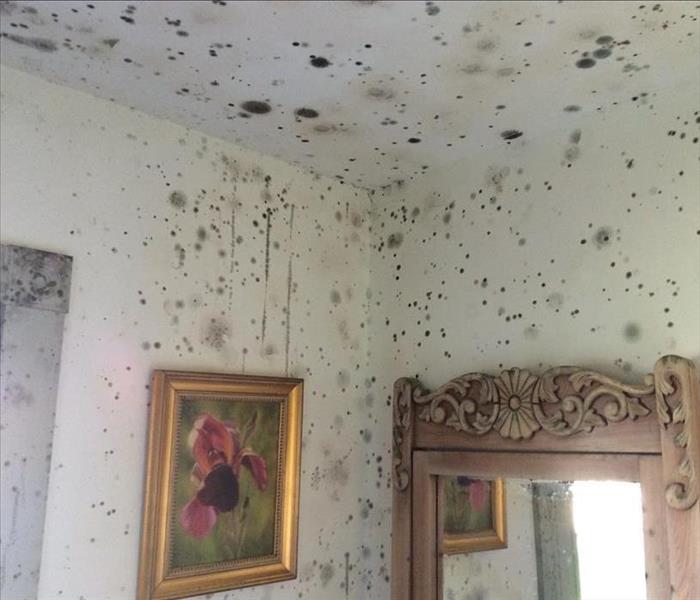 Understanding Mold
Understanding Mold
Understanding Mold
When water intrudes into your property, mold growth can start in as little as 48 hours. Consider the following mold facts:
- Mold is present almost everywhere, indoors and outdoors.
- Mold spores are microscopic, float along in the air, and may enter your home through windows, doors, or AC/heating systems or even hitch a ride indoors on your clothing or a pet.
- Mold spores thrive on moisture. Mold spores can quickly grow into colonies when exposed to water. These colonies may produce allergens and irritants and have the potential to cause other health effects.
- Before mold remediation can begin, any sources of water or moisture must be addressed. Otherwise, the mold may return.
- Mold often produces a strong, musty odor, and that odor can lead you to possible mold problem areas.
- Even higher-than-normal indoor humidity can support mold growth. Keep indoor humidity below 45 percent.
Have any questions and/or concerns about mold damage in your home or commercial buildings in the Kenton, Ada, Bellefontaine and/or Marysville,OH areas? Give us a call at (937)354-3540!
Mold FYI Blog- Hardin, Logan & Auglaize counties
3/30/2018 (Permalink)
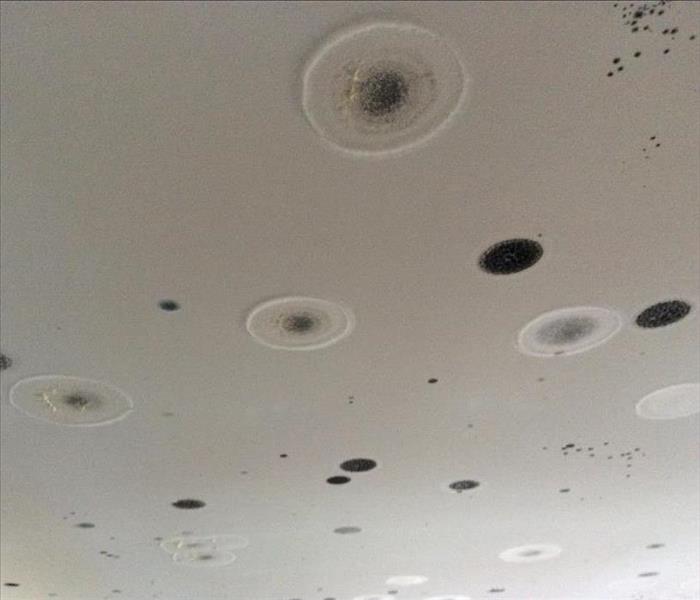 Mold Cultures
Mold Cultures
Common Mold Causes, Growing Conditions
Molds are found everywhere, and can grow on almost any substance when moisture is present. They reproduce by spores, which are carried by air currents. When spores land on a moist surface suitable for life, they begin to grow. Mold is normally found indoors at levels which do not affect most healthy individuals.
Because common building materials are capable of sustaining mold growth and mold spores are ubiquitous, mold growth in an indoor environment is typically related to water or moisture and may be caused by incomplete drying of flooring materials (such as concrete). Flooding, leaky roofs, building-maintenance or indoor-plumbing problems can lead to interior mold growth. Water vapor commonly condenses on surfaces cooler than the moisture-laden air, enabling mold to flourish. This moisture vapor passes through walls and ceilings, typically condensing during the winter in climates with a long heating season. Floors over crawl spaces and basements, without vapor barriers or with dirt floors, are mold-prone. The "doormat test" detects moisture from concrete slabs without a sub-slab vapor barrier. Some materials, such as polished concrete, do not support mold growth.
Significant mold growth requires moisture and food sources and a substrate capable of sustaining growth. Common building materials, such as plywood, drywall, furring strips, carpets, and carpet padding provide food for mold. In carpet, invisible dust and cellulose are food sources. After water damage to a building, mold grows in walls and then becomes dormant until subsequent high humidity; suitable conditions reactivate mold. Mycotoxin levels are higher in buildings which have had a water incident.
Mold FYI Blog #2- Hardin, Logan & Auglaize counties
3/30/2018 (Permalink)
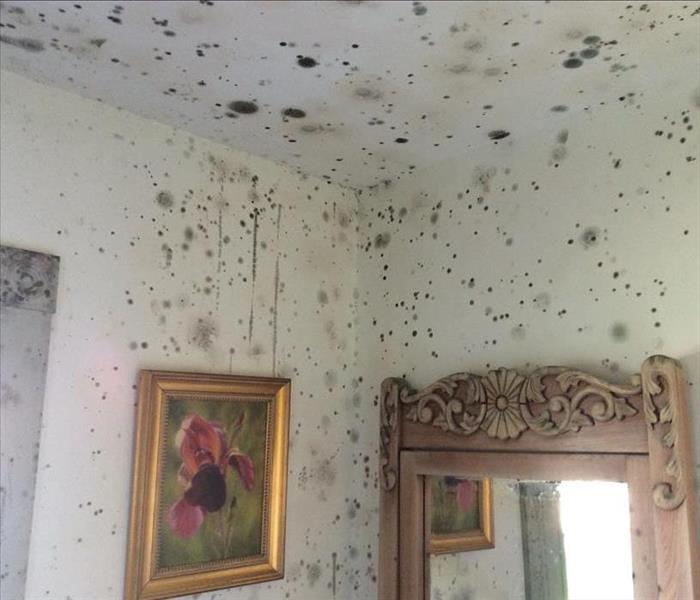 Mold
Mold
Mold is detectable by smell and signs of water damage on walls or ceiling, and can grow in places invisible to the human eye. It may be found behind wallpaper or paneling, on the inside of ceiling tiles, the back of drywall, or the underside of carpets or carpet padding. Piping in walls may also be a source of mold, since they may leak (causing moisture and condensation).
Spores need three things to grow into mold: nutrients - cellulose (the cell wall of green plants) is a common food for indoor spores; moisture - To begin the decaying process caused by mold; time -mold growth begins from 24 hours to 10 days after the provision of growing conditions.
Mold colonies can grow inside buildings, and the chief hazard is the inhalation of mycotoxins. After a flood or major leak, mycotoxin levels are higher even after a building has dried out.
Mold is detectable by smell and signs of water damage on walls or ceiling, and can grow in places invisible to the human eye. It may be found behind wallpaper or paneling, on the inside of ceiling tiles, the back of drywall, or the underside of carpets or carpet padding. Piping in walls may also be a source of mold, since they may leak (causing moisture and condensation).[8]
Spores need three things to grow into mold: nutrients - cellulose (the cell wall of green plants) is a common food for indoor spores; moisture - To begin the decaying process caused by mold; time -mold growth begins from 24 hours to 10 days after the provision of growing conditions.
Mold colonies can grow inside buildings, and the chief hazard is the inhalation of mycotoxins. After a flood or major leak, mycotoxin levels are higher even after a building has dried out.
Food sources for mold in buildings include cellulose-based materials such as wood, cardboard and the paper facing on drywall and organic matter such as soap, fabrics and dust-containing skin cells. If a house has mold, the moisture may originate in the basement or crawl space, a leaking roof or a leak in plumbing pipes. Insufficient ventilation may accelerate moisture buildup. Visible mold colonies may form where ventilation is poorest and on perimeter walls (because they are nearest the dew point).
Mold FYI Blog #3- Hardin, Logan & Auglaize counties
3/30/2018 (Permalink)
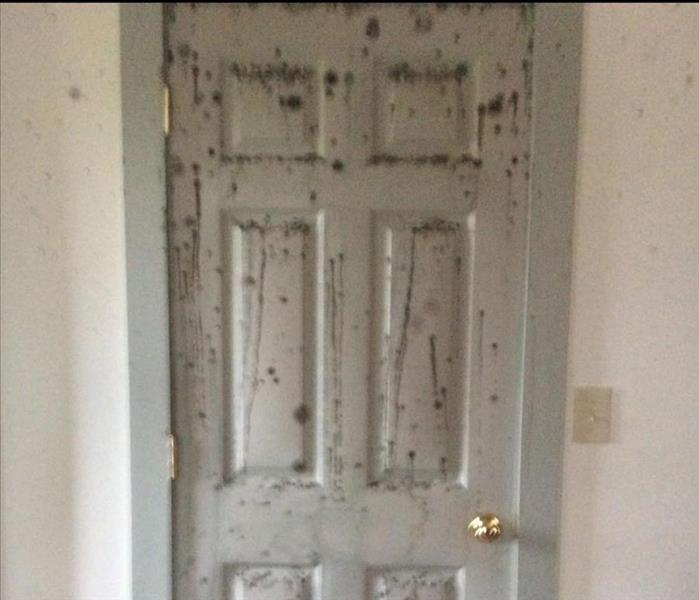 Mold
Mold
If there are mold problems in a house only during certain times of the year, the house is probably too airtight or too drafty. Mold problems occur in airtight homes more frequently in the warmer months (when humidity is high inside the house, and moisture is trapped), and occur in drafty homes more frequently in the colder months (when warm air escapes from the living area and condenses).
If a house is artificially humidified during the winter, this can create conditions favorable to mold. Moving air may prevent mold from growing, since it has the same desiccating effect as low humidity. Molds grow best in warm temperatures, 77 to 86 °F (25 to 30 °C), although growth may occur between 32 and 95 °F (0 and 35 °C).
Removing one of the three requirements for mold reduces (or eliminates) new mold growth: moisture; food for the mold spores (for example, dust or dander); and warmth since mold generally does not grow in cold environments.
HVAC systems can produce all three requirements for mold growth. The air conditioning system creates a difference in temperature, encouraging condensation.
The high rate of dusty air movement through an HVAC system may furnish ample food for mold. Since the air-conditioning system is not always running, warm conditions are the final component for mold growth.
Storm Damage Can Happen Anywhere and Anytime
3/30/2018 (Permalink)
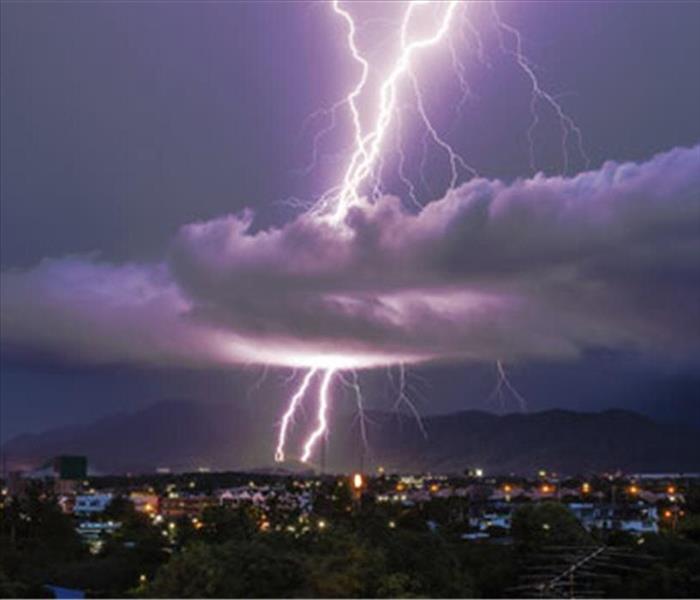 Damaging Storms
Damaging Storms
The following is an outline of a few of the key information points in a storm/water damage situation.
Different removal methods and measures are used depending on the category of water. Due to the destructive nature of water, chosen restoration methods also depend heavily on the amount of water, and on the amount of time the water has remained stagnant.
For example, as long as carpet has not been wet for longer than 48 hours, and the water involved was not sewage based, a carpet can usually be saved; however, if the water has soaked for longer, then the carpet is probably irreparable and will have to be replaced.
Water damage restoration can be performed by property management teams, building maintenance personnel, or by the homeowners themselves; however, contacting a certified professional water damage restoration specialist is often regarded as the safest way to restore water damaged property.
Give us a call to see if we may help you at (937)354-3540!
No job too BIG!
3/13/2018 (Permalink)
 School Bus 2017-2018
School Bus 2017-2018
We here at SERVPRO of central Auglaize, Hardin & Logan counties had the pleasure of working for Ridgemont local school district here in Hardin county recently.
The job was a BIG one to say the least. Not just in pure size alone, but logistics as well. The job was cleaning, waxing, and buffing 12 school buses, inside and out. while also coordinating the bus schedules, and our work schedules to coincide in harmony together.
The Ridgemont school bus coordinator (Connie Reel), was a pleasure to work with and really helped us with the logistics needed to get this done. Once a routine was developed we could have a full sized bus cleaned, waxed and buffed, inside and out in around 4-5 hours time, and ready for pickup.
We would like to thank Ridgemont Local School District for giving us the opportunity to make their buses shine, and look like the day they rolled off of the assembly line.
Take a look and see for yourself.
5 Ways to Exude Confidence Everywhere You Go
3/12/2018 (Permalink)
Whether you’ve moved to a new city, are looking for a job, want to start dating or simply make friends, networking will prove to be valuable. The challenge is networking in a way that goes beyond introductions and an exchange of business cards that get lost at the bottom of your desk. Especially if you lack confidence, leaving your house to go meet complete strangers can be incredibly challenging. Still, even if you’re socially awkward and an introvert, you can exude confidence and ace your networking goals.
I know this because I have learned to become extrovert for the sake of business networking. Naturally, at any given moment I’d prefer to be in bed, reading, or binge watching Netflix original series, but in order to not be a total shut-in in a city where I’ve lived for less than a year, I actually have to get out and talk to people.
This requires a heap load of motivation, focusing on my objective and reminding myself the entire Lyft ride there that I need to build relationships. Over the years, I’ve gotten better, and although it’s a mental exercise to get myself to an event, once I arrive, I ace it.
Here’s 5 ways you can exude confidence at any networking event you go to:
1. Map out your networking event plan
Anxiety has a way of making you a no-show although you RSVP’d on Eventbrite two weeks ago. Before registering for events, think through why you need to be there, what you want to get out of the event, who you want to meet and how you can turn it into an opportunity to advance a personal goal.
It helps to look up organizers, speakers, sponsors and attendees if that information is available. Meetup.com shares all of that information publicly so you can start there for finding events that work for you. Plan to leave well in advance so that you don’t add additional stress by running late, having to look for parking or worrying about getting lost.
Read the rest here. . .
Faster to your Kenton, Bellefontaine or Ada area Water Damage Event
3/9/2018 (Permalink)
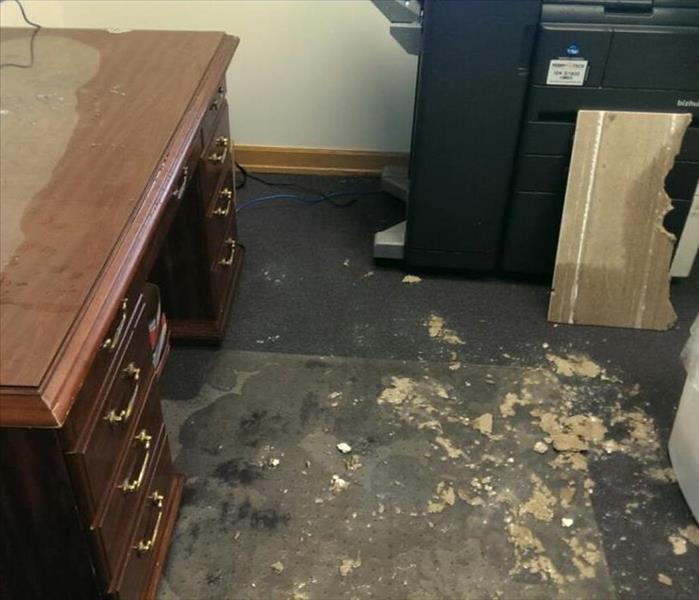 SERVPRO of Central Auglaize, Hardin & Logan counties provides 24 hour fire and water damage restoration service in Kenton, Bellefontaine or Ada areas
SERVPRO of Central Auglaize, Hardin & Logan counties provides 24 hour fire and water damage restoration service in Kenton, Bellefontaine or Ada areas
Flooding and water emergencies don’t wait for regular business hours and neither do we. SERVPRO of Central Auglaize, Hardin & Logan counties provides emergency cleaning and restoration services 24 hours a day, 7 days a week—including all holidays.
Faster To Any Size Disaster
Flooding and water damage is very invasive. Water quickly spreads throughout your home and gets absorbed into floors, walls, furniture, and more. SERVPRO of Central Auglaize, Hardin & Logan counties arrives quickly and starts the water extraction process almost immediately. This immediate response helps to minimize the damage and the cleaning and restoration costs.
Need Emergency Service? Call Us 24/7 – (937)354-3540
Water Damage Timeline
Within Minutes
- Water quickly spreads throughout your property, saturating everything in its path.
- Water is absorbed into walls, floors, upholstery, and belongings.
- Furniture finishes may bleed, causing permanent staining on carpets.
- Photographs, books, and other paper goods start to swell and warp.
Hours 1 - 24:
- Drywall begins to swell and break down.
- Metal surfaces begin to tarnish.
- Furniture begins to swell and crack.
- Dyes and inks from cloth and paper goods spread and stain.
- A musty odor appears.
48 Hours to 1 Week:
- Mold and mildew may grow and spread.
- Doors, windows, and studs swell and warp.
- Metal begins to rust and corrode.
- Furniture warps and shows signs of mold.
- Paint begins to blister.
- Wood flooring swells and warps.
- Serious biohazard contamination is possible.
More Than 1 Week:
- Restoration time and cost increase dramatically; replacing contaminated materials and structural rebuilding may be extensive.
- Structural safety, mold growth, and biohazard contaminants pose serious risks to occupants.
About SERVPRO of Central Auglaize, Hardin & Logan counties
SERVPRO of Central Auglaize, Hardin & Logan counties specializes in the cleanup and restoration of residential and commercial property after a fire, smoke or water damage event. Our staff is highly trained in property damage restoration. From initial and ongoing training at SERVPRO’s corporate training facility to regular IICRC-industry certification, rest assured our staff is equipped with the knowledge to restore your property.
For Immediate Service in Kenton, Bellefontaine, or Ada areas Call SERVPRO
3/8/2018 (Permalink)
 Hardin and Logan county Residents: We provide immediate service day or night!
Hardin and Logan county Residents: We provide immediate service day or night!
SERVPRO of Central Auglaize, Hardin & Logan counties provides 24-hour emergency service and is dedicated to being faster to any-sized disaster in Kenton, Bellefontaine and/or Ada areas. We can respond immediately to your emergency and have the expertise to handle your restoration or cleaning needs.
- 24-Hour Emergency Service
- Faster to Any-Sized Disaster
- Highly Trained Restoration Technicians
- A Trusted Leader in the Restoration Industry
- Locally Owned and Operated
- Advanced Restoration and Cleaning Equipment
Have Questions? Call Us 24/7 – (937)354-3540
Residential Services
Whether your Hardin or Logan county home needs emergency flood damage or your upholstery cleaned, you can depend on us. Our technicians have extensive cleaning and restoration training and can make your property look its best. Learn more about our residential services:
- Water Damage Restoration
- Fire Damage Restoration
- Mold Remediation
- Storm Damage Restoration
- Cleaning Services
- Building/Reconstruction Services
Commercial Services
There's never a convenient time for fire or Water damage to strike your Hardin or Logan county commercial property. Every hour spent cleaning up is an hour of lost revenue and productivity. So when the need arises for professional cleaning or emergency restoration services we have the training and expertise to respond promptly with highly trained technicians to get your property back to business. Learn more about our commercial services: http://www.SERVPROcentralauglaizehardinlogancounties.com/commercial-restoration-cleaning
- Commercial Water Damage Restoration
- Commercial Fire Damage Restoration
March Maintenance Guide
3/5/2018 (Permalink)
 It's spring! Get going on these important home maintenance projects.
It's spring! Get going on these important home maintenance projects.
Daylight savings time begins on March 11th and the first day of spring is officially March 20th, so this month marks that great transition from winter to spring. You may already be experiencing the first signs of spring like bulbs blooming, first blossoms on the trees and the inevitable spring allergies.
You’ll want to tune up your lawn mower and service any other outdoor equipment that helps you in the yard.As you walk around your home outside, take a look at the structure and see what needs taking care of. Your roof should be clear of moss, branches and leaves, so should your gutters. The siding may need to be cleaned or painted so if you need to get quotes from any professionals, this is the month to get them out to your house.
Although many of us are anxious to get out into the yard this month, there are still plenty of important projects to get done on the inside too. Transition months like March are perfect for reorganizing closets and putting away winter items and getting out the summer gear.
Roofs and gutters are the first defense for keeping the home dry and free from mold, so be sure to regularly remove snow and make sure the gutters and downspouts are clear for the spring thaw.
SOURCE
How to Remove Ivy
3/5/2018 (Permalink)
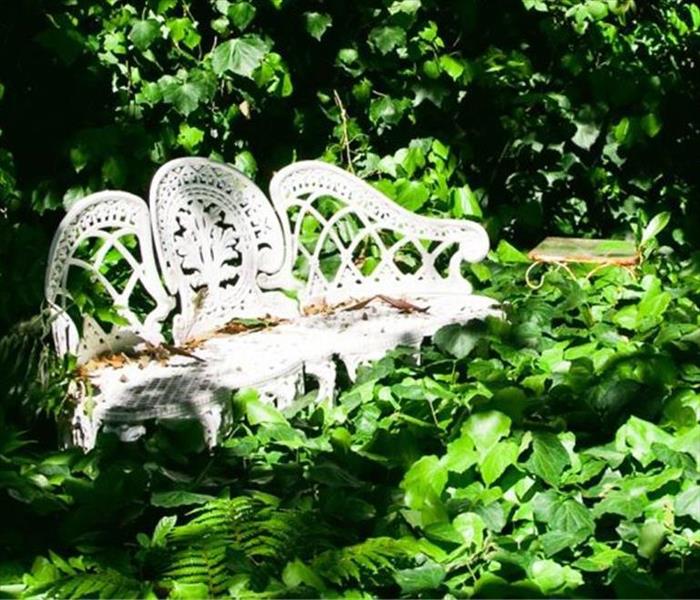 Ivy overtakes your property.
Ivy overtakes your property.
Removing invasive ivy from trees and walls can help keep them in healthy condition.
Removing invasive ivy from your yard is an important task, especially if it is actively growing on your trees, fence or home. Ivy can look beautiful growing up a traditional brick wall, but ivy can damage the mortar between the bricks (especially older brick walls), weaken stucco as well as wooden fences. Ivy growing up a tree trunk can also be damaging to the health of the tree, blocking out light and weakening the tree, making it susceptible to wind storms and slowly killing it. Whether you are trying to tame ivy in your yard or completely remove it, let’s take a look at the best way to get this task done.
About invasive ivy
Invasive ivy, like English Ivy, has woody stems, and mature ivy can look very different from new ivy. Mature ivy usually goes to seed in the late fall. Cool or cold temperatures are the best time of year to remove ivy as the growth is slower. If you try to cut ivy during the high growth season, the ivy will come back much faster. Once you’ve removed the ivy, do not throw it into your compost pile. Cut ivy can actually regrow, so dispose of it carefully.
Supplies:
- Cutting tools: you may need hand pruning sheers, a long handled lopper, or a serrated hand saw (for thicker stems)
- Rake or pitchfork: for clearing away the cut ivy
- Gloves and protective gear: you’ll want good gloves to grip the stems and rip them from the ground. When pruning and working in thick greenery, it’s a smart idea to protect your eyes as well as your skin.
How to remove ivy from a tree trunk or wall
- Step 1: Take your pruning tool and cut the ivy around the base of the tree trunk (about waist high). For a brick wall or wood fence, cut a horizontal line and be careful to not damage the wall with your tools.
- Step 2: Completely remove the ivy below your cut line, taking care not to pull too hard (the ivy stems can actually pull off tree bark, paint, stucco or brick mortar).
- Step 3: Pull out the ivy stems from the ground and clear it about 6 feet away from the trunk, wall or fence. Don’t pull green ivy that stretches high above your head; you may accidentally pull down a bird’s nest or bee’s nest.
- Step 4: Above your cut line, simply let the ivy die. Once the ivy has died and turned brown, it will be much easier to pull down and off of the tree, wall or fence.
SOURCE
Local Kenton,Ohio law enforcement responds to school threat
3/5/2018 (Permalink)
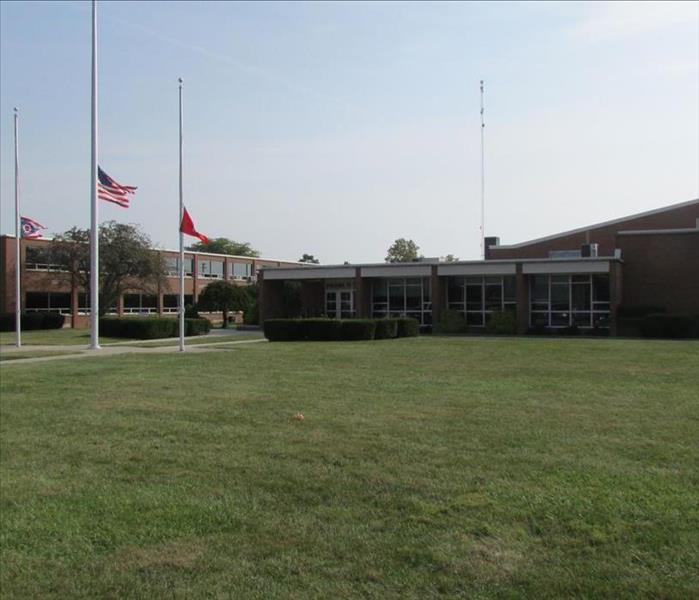 Kenton High School
Kenton High School
SERVPRO of Central Auglaize, Hardin & Logan counties would like to thank the Kenton Police Department for their tireless service to the community.
Let's hear it for our local Kenton law enforcement officers, for being there for the students. Thank you for keeping the community and our children safe!
"A threat was made to Kenton High School this evening.
On a recorded telephone message, Kenton High School Principal Chad Thrush explained that a broad, non-specific threat was made against the school. After school officials were notified, officers from the Kenton Police Department were contacted and an investigation was conducted.
The investigation concluded that no threat was apparent to school students or staff members. The school is set to start classes on time tomorrow, with a law-enforcement presence. Thrush also noted that the presence will be maintained by law-enforcement through the remainder of the school year."
Kenton Times
Fire Prevention Week
10/13/2016 (Permalink)
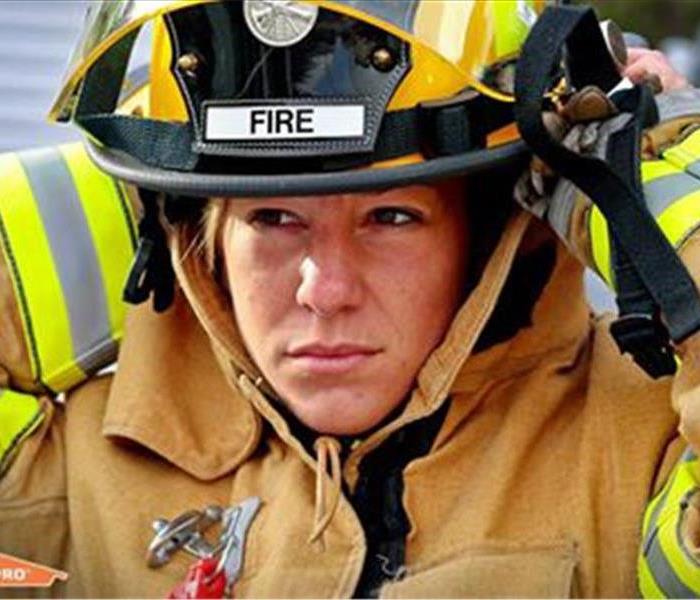 fire fighter
fire fighter
Today kicks off #FirePreventionWeek! Take some time to go over safety tips with your family and be sure to thank the men & women who sacrifice their lives to protect us from the flames.
SERVPRO supports the American Red Cross by asking every household in America to join us in taking two simple steps that can save lives; checking or installing smoke alarms and practicing fire drills at home.
A home is more than a supportive structure. It shelters you, your family, and all of your treasured keepsakes. What if you had the power to prevent the loss of your home? Well, the American Red Cross can give you some of that power by learning proper home fire prevention and safety.
Carpet Cleaning
5/27/2016 (Permalink)
 Carpet
Carpet
Carpet cleaning is important to maintaining the overall comfort and monetary value of a property. Any type of flooring is an investment for the property owner. Keeping the investment in the best shape takes a professional, but without proper certification, the consumer cannot be guaranteed of proper education and training on updated techniques used in maintaining the value of the flooring.
There are health concerns that can arise from any unsanitary environment, and it can be surprising to learn what survives in and under the flooring. Allergens that are left behind can lead to serious health problems for family members and even household pets. Proper techniques can reduce or eliminate allergens in the environment, improving the health of the occupants.
Great strides have been made in technologies used in carpet-care. Today there are only a few basic wet and dry methodologies accepted by the industry leaders. Ensuring consistently high standards means understanding how the certifying body works to guarantee better results at lower costs.
Proper maintenance begins with regular vacuuming using a high-powered machine. Over time normal wear and tear leads to a dull, soiled appearance. Proper maintenance by the occupants can help keep the flooring looking good, but there comes a time when a certified technician has to be called to get to the really deep grime a normal household vacuum can miss.
While regular maintenance is beneficial to the healthfulness and attractiveness of a home or office, a certified technician is necessary to take care of the really deep jobs regular vacuuming misses.
Consumers often find it difficult to choose a professional company for those important household chores. The benefits of carpet cleaning are numerous, but knowing who can be trusted is not always easy. That's where we come in....Just give us a call @ (937)354-3540 and we'll help you in any way that we can, whether that be by offering our carpet claeaning services or just answering any questions you may have.
Extreme Heat and Your Health
5/24/2016 (Permalink)
 Extreme heat safety
Extreme heat safety
Heat-related deaths and illness are preventable, yet annually many people succumb to extreme heat.
Keep your body temperature cool to avoid heat-related illness.
Keep your body temperature cool to avoid heat-related illness.
- Stay in air-conditioned buildings as much as possible.
- Find an air-conditioned shelter.
- Do not rely on a fan as your primary cooling device.
- Avoid direct sunlight.
- Wear lightweight, light-colored clothing.
- Take cool showers or baths.
- Check on those most at-risk twice a day.
- Never leave infants or children in a parked car. Nor should pets be left in parked cars—they can suffer heat-related illness too.
- Dress infants and children in loose, lightweight, light-colored clothing.
- Seek medical care immediately if your child has symptoms of heat related-illness.
Because your body loses fluids through sweat, you can become dehydrated during times of extreme heat.
- Drink more water than usual.
- Don’t wait until you’re thirsty to drink more fluids.
- Drink from two to four cups of water every hour while working or exercising outside.
- Avoid alcohol or liquids containing high amounts of sugar.
- Remind others to drink enough water.
Stay updated on local weather forecasts so you can plan activities safely when it’s hot outside.
- Check local news for extreme heat alerts and safety tips.
- Learn the symptoms of heat illness.
How to stay cool in extreme heat -Video
SOURCE
Extension Cord Safety Tips
5/12/2016 (Permalink)
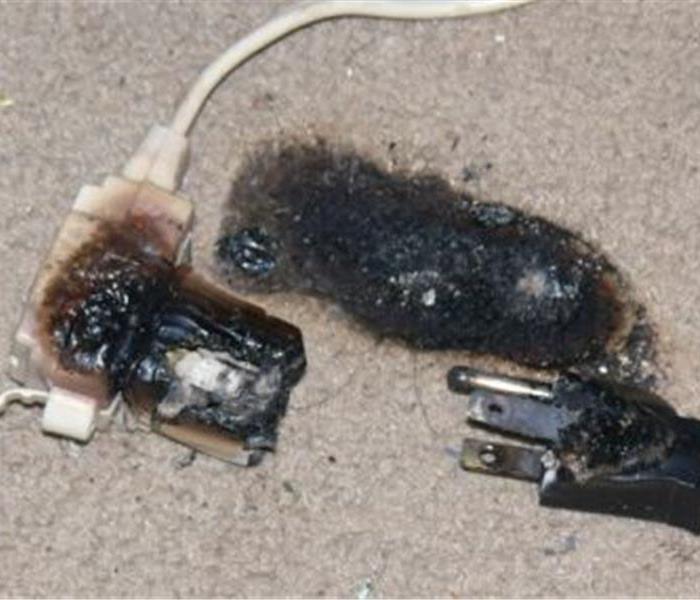 Extension cord safety
Extension cord safety
Not enough cord for your lamp or radio to reach the nearest outlet? Just plowing through the junk drawer for an extension cord? This may not be a good idea. Extension cords can be very helpful in delivering power right where we need it. However, regardless of the gauge or rating of the cord, an extension cord is a temporary solution, and is not meant to be used as a long-term extension of your household’s electrical system.
Using extension cords properly is critical to your safety. With continuous use over time, an extension cord can rapidly deteriorate, creating a potentially dangerous electric shock or fire hazard. The Electrical Safety Foundation International (ESFI) offers the following tips for staying safe from electric shock and electrical fires:
- Do not overload extension cords or allow them to run through water or snow on the ground.
- Do not substitute extension cords for permanent wiring.
- Do not run through walls, doorways, ceilings or floors. If cord is covered, heat cannot escape, which may result in a fire hazard.
- Do not use an extension cord for more than one appliance.
- A heavy reliance on extension cords is an indication that you have too few outlets to address your needs. Have additional outlets installed where you need them.
- Multiple plug outlets must be plugged directly into mounted electrical receptacles; they cannot be chained together.
- Make sure the extension cord or temporary power strip you use is rated for the products to be plugged in, and is marked for either indoor or outdoor use.
- The appliance or tool that you are using the cord with will have a wattage rating on it. Match this up with your extension cord, and do not use a cord that has a lower rating.
- Never use a cord that feels hot or is damaged in any way. Touching even a single exposed strand can give you an electric shock or burn.
- Never use three-prong plugs with outlets that only have two slots for the plug. Do not cut off the ground pin to force a fit. This defeats the purpose of a three-prong plug and could lead to an electrical shock. Never force a plug into an outlet if it doesn’t fit.
- Use extension cords with polarized and/or three-prong plugs.
- Buy only cords approved by an independent testing laboratory, such as Underwriters Laboratories (UL), ETL-SEMKO (ETL) or Canadian Standards Association (CSA).
- Do not substitute extension cords for permanent wiring.
SOURCE LINK
Free CE Class- Ethics
4/27/2016 (Permalink)
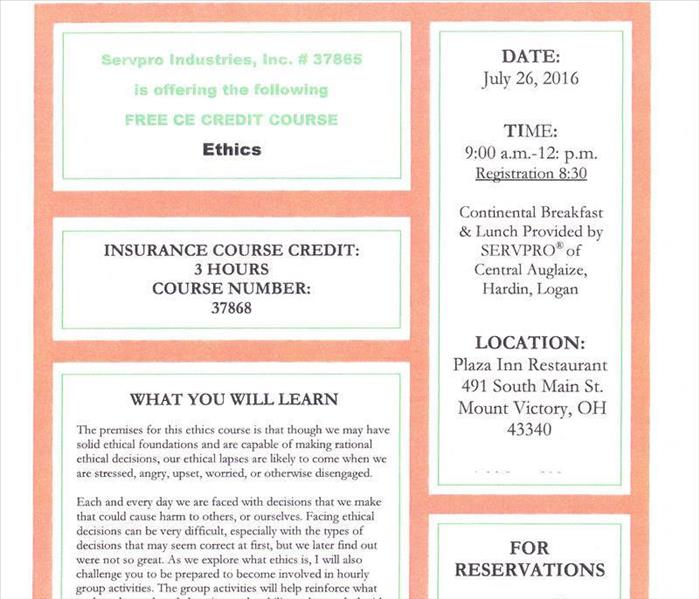 CE Class Flyer
CE Class Flyer
WHAT YOU WILL LEARN
The premise for this ethics course is that though we may have solid ethical foundations and are capable of making rational ethical decisions, our ethical lapses are likely to come when we are stressed, angry, upset, worried, or otherwise disengaged.
Each and every day we are faced with decisions that we make that could cause harm to others, or ourselves. Facing ethical decisions can be very difficult, especially with the types of decisions that may seem correct at first, but we later find out were not so great. As we explore what ethics are, I will also challenge you to be prepared to become involved in hourly group activities. The group activities will help reinforce what we have learned, and also give us the ability to better deal with ethical decision making in our own lives.
* Continental breakfast & Lunch provided by : SERVPRO of central Auglaize, Hardin & Logan counties *
LOCATION:
Plaza Inn Restaurant
491 S. Main St.
Mount Victory ,OH 43340
FOR RESERVATIONS:
Call us @ 937-354-3540
or email us
SERVPRO8463@dbscorp.net
National Cancer Control Month, 2016
4/12/2016 (Permalink)
 National Cancer Control Month - April 2016
National Cancer Control Month - April 2016
NATIONAL CANCER CONTROL MONTH, 2016
- - - - - - -
BY THE PRESIDENT OF THE UNITED STATES OF AMERICA
A PROCLAMATION
Undaunted by challenge and unceasing in pursuit of progress, our Nation has pushed the boundaries of possibility throughout our history. Today, while cancer remains among the leading causes of death around the world and the second leading cause of death here at home, cancer research is on the cusp of major breakthroughs, offering incredible promise to those suffering from this disease. This month, we remember the loved ones we have lost, pledge support for the families we can still save, and reaffirm our commitment to curing cancer once and for all.
Cancer can affect people of all ages, races, and backgrounds, but certain risk factors exist that can often be mitigated. Limiting alcohol consumption, controlling sun exposure, exercising, getting recommended cancer screenings, and maintaining a healthy diet are all ways to reduce your risk of getting cancer. Additionally, smoking remains one of the top causes of cancer, responsible for 1 in 3 cancer deaths in the United States. By promoting resources to help people quit smoking and limiting exposure to secondhand smoke, we can reduce individuals' cancer risks. Help for quitting smoking can be found at www.SmokeFree.gov or by calling 1-800-QUIT-NOW. I urge all Americans to visit www.Cancer.gov or www.CDC.gov/Cancer to learn more.
National Big Wind Day
4/12/2016 (Permalink)
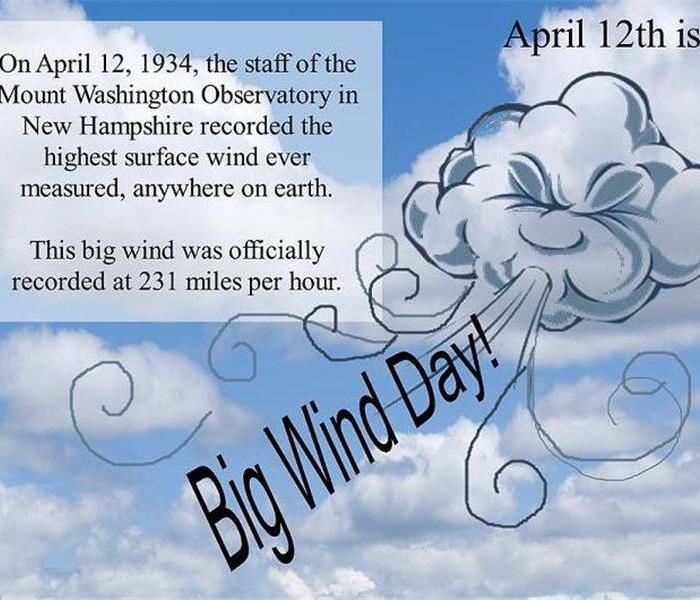 National big wind day
National big wind day
Date When Celebrated : Always April 12th
Big Wind Day commemorates the highest wind speed ever recorded on the planet. Can you guess where? No, it wasn't in the middle of a hurricane or a tornado.
On April 12, 1934, the staff of the Mount Washington Observatory recorded the highest surface wind ever measured, anywhere on earth. This big wind was officially recorded at 231 miles per hour. Imagine the difficulties of even making a recording under those conditions back then!
It can still be argued that Mount Washington holds the record for the highest surface wind speed recorded 'by man'; the new Australian record of 2010 was measured by an automated station while no human was present, while the Mount Washington wind gust was actually measured by a human being.
Phenomena measured via satellite or radar, such as tornadoes, hurricanes, and air currents in the upper atmosphere, are not directly measured at the Earth's surface and do not compete with either of these records. Will this record ever be broken? Perhaps, but until then, enjoy Big Wind Day.
Tips to Prevent a Cooking Fire
4/1/2016 (Permalink)
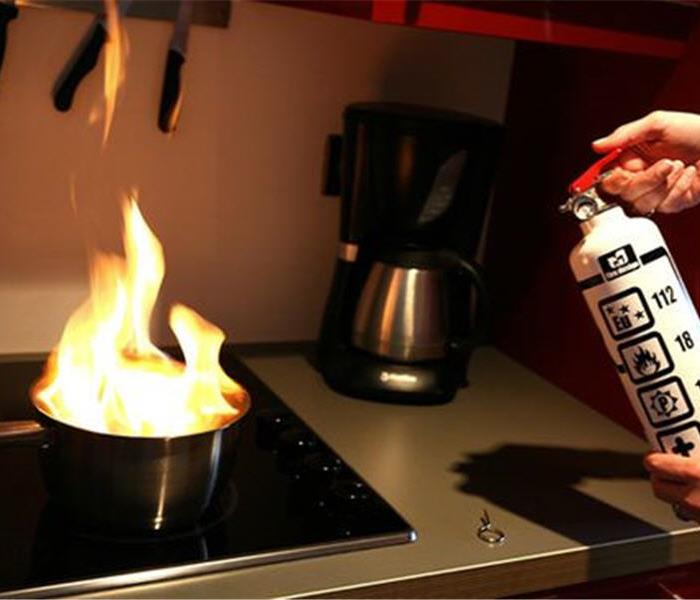 Kitchen Fire
Kitchen Fire
*Keep an eye on your cooking and stay in the kitchen. Unattended cooking is the leading cause of cooking fires.
*Wear short or close-fitting sleeves. Loose clothing can catch fire.
*Watch children closely. When old enough, teach children to cook safely.
*Clean cooking surfaces to prevent food and grease build-up.
*Keep curtains, towels and pot holders away from hot surfaces and store solvents and flammable cleaners away from heat sources. Never keep gasoline in the house.
*Turn pan handles inward to prevent food spills.
*If you have to leave the kitchen, even for a second, turn off the stove.
*Use a timer so you’ll remember that the stove or oven is on.
*Keep the kids away from the cooking area. Enforce a “kid-free zone” and make them stay at least three feet away from the stove.
*Consider purchasing a fire extinguisher to keep in your kitchen. Contact your local fire department to take training on the proper use of extinguishers.
Out of sight ...out of mind. Sump Pump Backup in Columbus,OH
4/1/2016 (Permalink)
 Flooded Basement
Flooded Basement
As mechanical things go, we don’t often think about the sump pump. It’s down in the basement, out of sight and out of mind. In reality, your sump pump is one of the hardest working pieces of equipment in your house.
A typical submersible sump pump drains water year round, and when a rainstorm hits the water pump works extra duty keeping your basement from flooding. Most homes have sump pumps to aid in basement drainage. So, here are a couple of things to consider:
Sump pumps are mechanical and will eventually fail. Average sump pump life is 10 years. The most common reason for failure is the sump pump switch.
If your sump pump fails during a rain storm, hundreds of gallons of water can flood your basement in a matter of minutes. It doesn’t take much water to cause thousands of dollars in damage.
Basement flooding can ruin your furnace, water heater and other mechanical and electrical devices. According to the Gas Appliance Manufacturers Association these appliances must be replaced.
Sump pumps should be checked for proper operation a couple of times per year – pour some water into the sump pit until the submersible pump cycles. This is usually an easy process and only takes a couple of minutes. Don’t wait for a failure during a rainstorm to find out your sump pump doesn’t work.



 24/7 Emergency Service
24/7 Emergency Service
